#Wall mount sensor node
Explore tagged Tumblr posts
Text
Arduino PLC | MQTT End Device | Industrial IoT device manufacturer | norvi.lk
How Programmable IoT Devices Operate
Having access to the most dependable and effective hardware speeds up the completion of your project. The ability to programme flexibly.
ESP32 Ethernet Device
When using ESP32 Ethernet, the NORVI ENET series is the best option because it has industrial-grade I/O and voltages. Both wireless and cable connectivity to the network are offered by ESP32 Ethernet.
Industrial Arduino Mega
The NORVI Arita is an enhanced version of the NORVI Series. Five conventional variants with a choice of two potent microprocessors are offered. Arita is built to deliver all of the micro-controller's performance while maintaining reliability. It works with practically all industrial input and output formats.
Arduino based Industrial Controller
Arduino IDE-programmable
Integrated OLED and customizable buttons for HMI
The ability to programme flexibly
LED signals for simple diagnosis
Applications Using a Programmable MQTT Device and Ultra Low Energy Batteries
Agent One Industrial Controllers are available for low power applications as well; STM32L series microcontroller-controlled devices are employed in ultra low power applications, where the devices must be powered by batteries for an extended period of time. When a device goes to sleep, the Agent One BT family is specifically built with transistor outputs to turn off external sensors.
Wall mount IoT Node
The NORVI SSN range is designed for independent installations in industrial settings with a focus on tracking sensor data or parameters from external devices. The implementations are made simple by the attachments for wall installation and pole mount.
NORVI Controllers
Our Address :
ICONIC DEVICES PVT LTD
Phone : +94 41 226 1776 Phone : +94 77 111 1776
E-mail : [email protected] / [email protected]
Web : www.icd.lk
Distributors
USA
Harnesses Motion LLC
1660 Bramble Rd. Tecumseh, MI
49286, United States
Phone : +1 (734) 347-9115
E-mail : [email protected]
EUROPE
CarTFT.com e.K.
Hauffstraße 7
72762 Reutlingen
Deutschland
Phone : +49 7121 3878264
E-mail : [email protected] MQTT End Device | Arduino PLC | Analog Input | Wireless sensor | ModBus MQTT gateway | Industrial IoT device manufacturer | WiFi Data logger
#Programmable IoT Devices#Industrial IoT Devices#Industrial Arduino#Arduino PLC#ESP32 Ethernet Device#Programmable Ethernet IoT Device#MQTT End Device#Industrial Arduino Mega#Arduino Mega PLC#Arduino based Industrial Controller#Programmable MQTT Device#Modbus MQTT Device#ESP32 Modbus device#Wall mount IoT Node#Wall mount sensor node#Programmable sensor node#Wireless sensor#Battery Powered IoT Node#Battery Powered Programmable Sensor node#Solar powered sensor node#MODBUS RTU ESP32#Modbus to IoT gateway#Modbus MQTT gateway#Programmable MQTT devices#MQTT over WIFI devices#MQTT over Ethernet devices#Industrial IoT device manufacturer#0 - 10V Arduino device#4 - 20mA Arduino device#ESP32 data logger
1 note
·
View note
Note
I did actually intend for it to be read as multiple dicks lol ;) glad you caught onto that. Maybe they’re slightly translucent so you can see eggs travel thru while breeding their mate? I also imagine they’re kind of prehensile and soft in the way that they can move to further push inside. Him stuffed full of as many tentacles as possible, taking clutch after clutch with eggs, his protoform and valve expanding and stretching to accommodate?
Sunstreaker bundled up safe and snug in the hive's nest, attendant drones making sure he's comfy as he's constantly mounted and bred full of eggs...
Being empty aches, he's unresisting as the next insecticon climbs on his back and he feels the inquisitive little tendrils probing his slit. His now constantly-dripping valve is spread open, larger tentacles gliding into him effortlessly. The aperture of his tank can't close anymore after laying so many eggs, and the ovipositor is right on target as it starts stuffing Sunny's tank with them, hundreds of squishy little orbs that will spend weeks growing inside him
Finally, the insecticon gets to the best part: making sure the eggs are fertilized with lots of transfluid and ignited by lots of Sunny's overloads. Dozens more tentacles invade his valve, writhing against his walls, as the iris of his tank is stuffed with the tips of as many as physically possible
His first overload hits him hard when he feels the transfluid spraying into his tank, but the insecticon uses the opportunity of his flexing valve to stuff it with even more tendrils. Sunny never gets any time to recover as the tentacles target his internal nodes, firmly pressing into every sensor as his valve is filled to max capacity
The insecticon stays locked on his back for days, the wriggling tendrils in his valve never stopping. When it finally decides the job is done, there's one last step before it can dismount...
A tentacle spends the final few hours filling him with a jelly-like fluid that will harden and plug his hole, keeping the eggs inside him until they've grown large enough to survive without incubation. Poor Sunny can't have anything else in his valve anymore, but there's always an attendant sucking his outer note to make sure the eggs still get energy from Sunny's overloads
When the plug dissolves, the eggs spill out of his loose valve, warm with newly-ignited sparklight <3
#valveplug#mine#bugfucking#tentacle tag#eggs#mechpreg#sunstreaker#ment to get to this earlier but i wasnt in a writing mood yesterday#3nthusiasts inbox
75 notes
·
View notes
Text

In the year 2424, Temple Church no longer stood as a mere relic of medieval London, but as a pivotal node in the sprawling underground network of the Resistance, a group fighting against the oppressive Regime that controlled the city. The church's ancient walls, once resonant with the sounds of prayer, now echoed with the murmur of strategic meetings and the soft steps of stealthy operatives.
At the center of this resistance was Ava, known amongst her peers as the Raven, a nickname inspired by her jet-black corset lined with blue—a nod to the ancient stained glass that once filled the church's windows. Ava's role was critical; she was a courier of vital information, using her extensive knowledge of the city’s old and new architecture to navigate unseen.
One foggy evening, Ava received a transmission encrypted with a code only known to the highest echelons of the Resistance. The message was clear: a new weapon, capable of turning the tide against the Regime, had been developed, and the prototype was hidden within the depths of the old Temple Church itself. Her mission was to retrieve it before the Regime's sensors detected an anomaly in the area.
Navigating through the catacombs beneath the city, Ava made her way into the church, her modern attire contrasting sharply with the crumbling gothic architecture. As she descended into the crypt, her eyes adjusted to the dim light emitted by bioluminescent fungi—an accidental, yet beautiful consequence of the new world.
Reaching the vault hidden beneath the effigy of a long-forgotten knight, Ava used her cybernetic enhancements to bypass the ancient locks, upgraded with state-of-the-art security systems by the Resistance. Inside, she found the device, a small, seemingly innocuous cube pulsing with blue light. As she reached out to grasp it, the ground trembled—a warning of the Regime's approaching forces, guided by their network of surveillance.
With the weapon secured, Ava activated her stealth mode, a sophisticated cloaking technology that rendered her nearly invisible. She moved swiftly, blending into the shadows cast by the moonlight filtering through the broken roof. The race back to the Resistance's base was fraught with close encounters and narrow escapes, but Ava's agility and cunning kept her one step ahead of her pursuers.
Back at the base, the weapon was revealed to be a source of electromagnetic pulse technology, capable of disabling the Regime's surveillance drones and control devices without causing harm to humans. With this new asset, the Resistance could finally mount a significant attack to reclaim their city and restore freedom to its citizens.
Ava, once a mere courier, had proven herself to be a key figure in what would be remembered as the beginning of the Great Revolt, a turning point in the history of the new world, with Temple Church at its heart—a beacon of hope and a symbol of resistance.
0 notes
Text
Review, teardown, and testing of RSP-320-24 Mean Well power supply
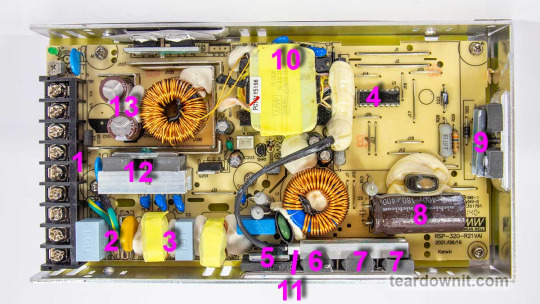
The RSP-320-24 is a 24-volt power supply with a maximum current of 13.4 amps. The supported mains voltage is from 100 to 240 volts without an additional switch. The supply measures 8.5 × 4.5 × 1¼ inches (215 × 115 × 30 millimeters), made on a printed circuit board fixed to the base's case. The top cover is perforated at the back near the connection terminals and on the front, where the cooling fan is installed. The fan starts spinning even if there's no electrical load. As the load increases, the fan speeds up, following the load current value. The fan sucks in the air and pushes it through the internal case volume to the perforated holes, including those on the side walls.
The input and output circuits are connected to a standard screw terminal block (1), from right to left: 3 terminals for the input line, neutral and ground wires, and 3 in parallel for common and +24V output. The input voltage from the terminals goes to the fuse (2), then to the pulse limiter (varistor), followed by the RF interference filter (3), and finally to the diode bridge (5). Next comes the active PFC, controlled by the PFC+PWM controller FAN4800 (4). Indeed, with a 234-volt AC power input, we get a rectified voltage on the storage capacitor (8) of 377 volts, approximately 47 volts more than without PFC Boost. The small voltage reserve is confusing since the capacitor installed is rated for 180 uF and 400 volts. All that's left is to rely on Nichicon's quality control.
The power part of the PFC is made of two parallel MOSFETs, IPP60R280P6 (7) and on an ultrafast diode 8A 600V STTH8S06D (6). The temperature sensor (11) is mounted above the PFC elements. The output voltage from the PFC is supplied to the two-transistor forward converter; the transistors are IPP60R280P6 (9) and are controlled by the same FAN4800 controller. The transformer (10) converter voltage is rectified and supplied to the LC filter. The output rectifier comprises eight diodes connected in two parallel groups (12). Total output capacitance: 2 pieces of 1000uF, 35V, designed for operating temperatures up to 220°F (105°C) (13). The output high-current circuits are reinforced with tinned copper busbars.
The control signal from the high-voltage side to the low-voltage side is transmitted through transistor optocouplers (there are two of them in the photo above the transformer hidden under a blob of the compound). One optocoupler is the primary regulation channel, and the second forms a backup channel for overvoltage protection, OVP.

The block diagram in the datasheet shows the "Active Inrush Current Limiting" node. Still, we could not find components on the board that could perform such a role. Still, the inrush current limitation element is present, marked as RTH1 on the board, and installed near the boost inductor PFC; most likely, this is an ordinary NTC.
The high-voltage part of the board, starting with the capacitor (8) and ending with the transformer leads (10), is coated on the high-voltage side with a protective composite, presumably epoxy-based, which further increases electrical safety.
There is additional insulation and a thin sheet of fiberglass between the aluminum case and the board (solder side).
The overall build quality is good.
Test conditions
Most tests use metering circuit #1 (see appendices) at 80°F (27°C), 70% relative humidity, and 29.8 inHg pressure. The measurements were performed without preheating the power supply with a short-term load unless mentioned otherwise.
The following values were used to determine the load level:

Output voltage under a constant load

The high stability of the output voltage should be noted.
Power-on parameters
Powering on at 100% load
The power supply is turned off at least 5 minutes before the test, with a 100% load connected. The oscillogram of switching to a 100% load is shown below (channel 1 is the output voltage, and channel 2 is the current consumption from the grid):
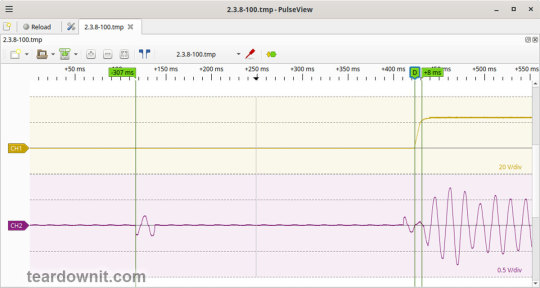
The picture shows three distinguishable phases of the power-on process:
The pulse of the input current charging the input capacitors when connected to the grid has an amplitude of about 2 A and a duration north of the mains voltage period.
Waiting for the power supply control circuit to start for about 300 ms.
(Output Voltage Rise Time) Starting the converter, increasing the output voltage, and entering the operating mode takes 8 ms.
(Turn On Delay Time) The entire process of entering the operating mode from the moment of powering on is 315 ms.
(Output Voltage Overshoot) The switching process is aperiodic; there is no overshoot.
Powering on at 0% load
The power supply is turned off at least 5 minutes before the test, with a 100% load connected. Then, the load is disconnected, and the power supply is switched on. The oscillogram of switching to a 0% load is shown below:
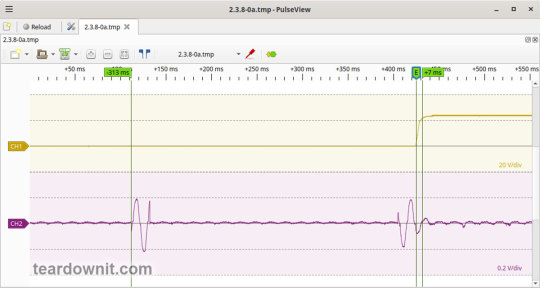
The picture shows three distinguishable phases of the power-on process:
The pulse of the input current charging the input capacitors when connected to the grid has an amplitude of about 2.2 A and a duration slightly longer than one mains period.
Waiting for the power supply control circuit to start for about 300 ms.
(Output Voltage Rise Time) Starting the converter, increasing the output voltage, and entering the operating mode takes 7 ms.
(Turn On Delay Time) The entire process of entering the operating mode from the moment of powering on is 320 ms.
(Output Voltage Overshoot) The switching process is aperiodic; there is no overshoot.
Power-off parameters
The power supply was turned off at 100% load, and the input voltage was nominal at the moment of powering off. The oscillogram of the shutdown process is shown below:
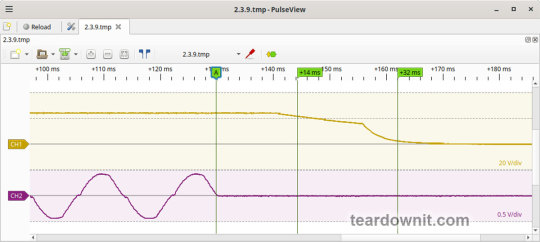
The picture shows two phases of the shutdown process:
(Shutdown Hold-Up Time) The power supply continues to operate due to the input capacitors holding charge until the voltage across them drops to a certain critical level, at which maintaining the output voltage at the nominal level becomes impossible. The phase takes 14 ms.
(Output Voltage Fall Time) Reduction of the output voltage, stopping voltage conversion, and accelerating the voltage drop takes 18 ms.
(Output Voltage Undershoot) The shutdown process is aperiodic; there is no overshoot.
Right before shutdown, the current waveform at 100% load is close to sinusoidal with an amplitude of 4.22 A.
Ripple output voltage
100% load
At 100% load, the low-frequency ripple is approximately 3 mV.

At 100% load, the ripple at the converter frequency is approximately 50 mVp-p, and the noise is 120 mVp-p.
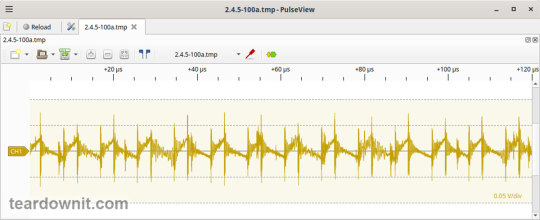
75% load
At 75% load, the low-frequency ripple is approximately 3 mV.

At 75% load, the ripple at the converter frequency is approximately 40 mVp-p, and the noise is 120 mVp-p.
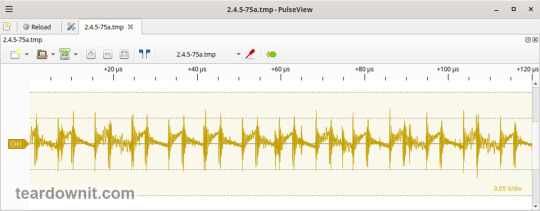
50% load
At a 50% load, the low-frequency ripple is approximately 3 mV.

At 50% load, the ripple at the converter frequency is approximately 30 mVp-p, and the noise is 70 mVp-p.
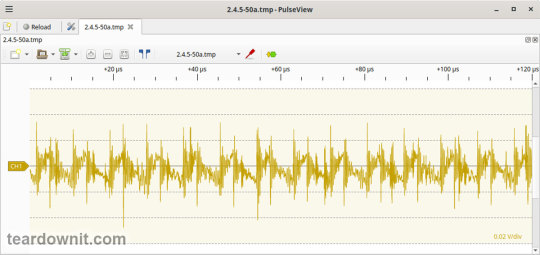
10% load
At 10% load, the low-frequency ripple is approximately 2 mV.
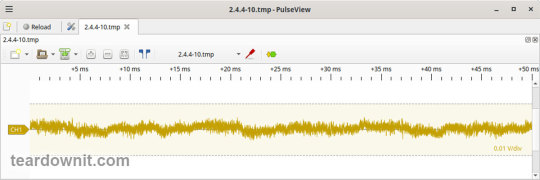
At a 10% load, the ripple at the converter frequency is approximately 20 mVp-p, and the noise is 90 mVp-p.
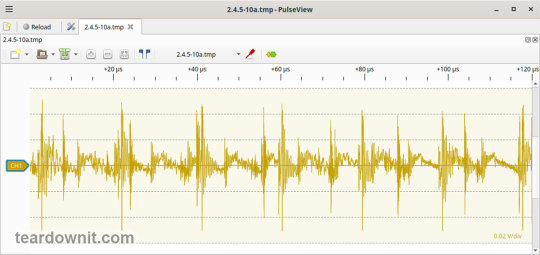
0% load
No-load current consumption measured with a multimeter: 53.5 mA.
(Power Consumption) The first assumption of excessive standby power draw of more than 6.5 watts is wrong since the current in this mode is predominantly reactive. Indeed, the input filter in the circuit contains two capacitors with a combined capacitance of 1.5 μF. Measuring the exact active power consumption at a 0% load with a basic set of instruments (oscilloscope, multimeter, etc.) is impossible.
At 10% load, the low-frequency ripple is approximately 2 mV.
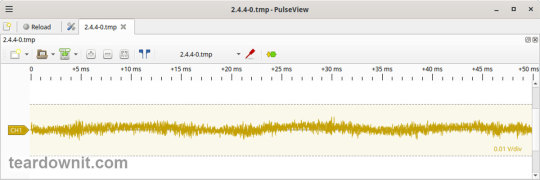
At 10% load, ripples at the converter frequency are masked by the 90 mVp-p noise.
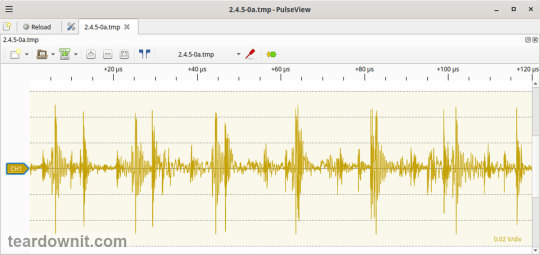
Dynamic characteristics
TA mode with periodic switching between 50% and 100% load was used to evaluate the dynamic characteristics. The process oscillogram is shown below:
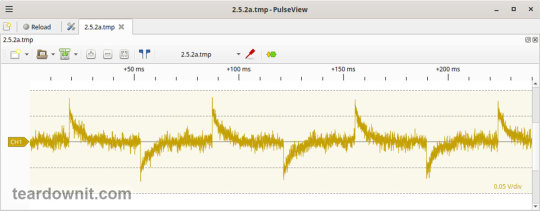
It is evident that the supply’s response to loading changes is close to aperiodic, and there is no overshoot, which indicates a good stability margin. The magnitude of the response to load changes is just 60 mV.
Overload protection
The claimed protection type is "hiccup mode, recovers automatically after fault condition is removed." This was confirmed during testing. When a short circuit occurs, the power supply periodically tries to turn back on and, if the overload is still present, turns off again until the next attempt. This operating mode reduces energy losses and heating during overload. Still, it does not allow the parallel connection of multiple power supplies with a common output.
The output current for the overload protection to kick in is 17 A.
Input circuit safety assessment
(Input discharge) Safety assessment is based on the discharge time constant of the input circuits when disconnected from the grid; the value is 0.26 s. This means that when operating on a 120 V input voltage, the time required to discharge the input circuits to safe values (<42 V) will be 0.41 s:

Important: The result is valid for this particular power supply unit; it was obtained for testing purposes and should not be taken as a safety guarantee.
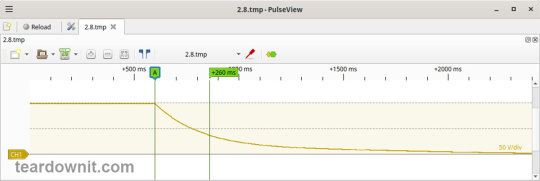
The leakage current at the ground pin is less than 10 µA.
Thermal conditions
When operating with no load connected, no component overheating had been noticed. Thermograms were captured at three power levels: 80, 90, and 100%, fully assembled and with the lid removed. Thermal images show that the most loaded element of the block is the input diode bridge, and its heating seriously stands out against the background of all the other components.
Unfortunately, already at 80% load, the diode bridge heats up to an unacceptable level of 259°F (126°C), which is dangerous for long-term operation.
80% load
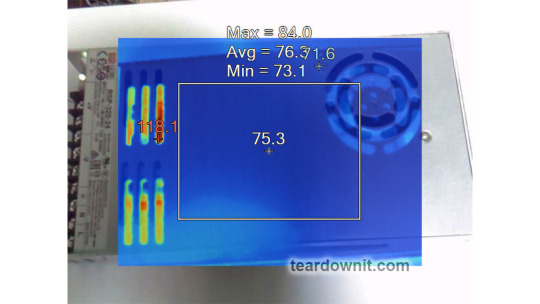
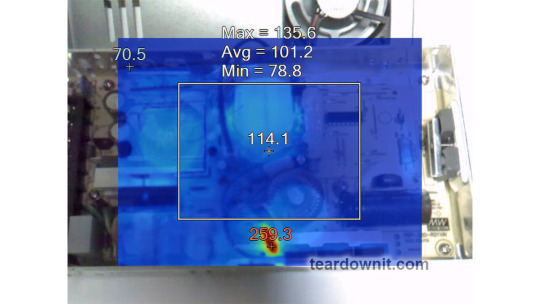
90% load
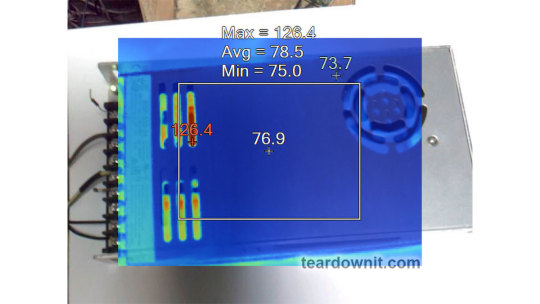
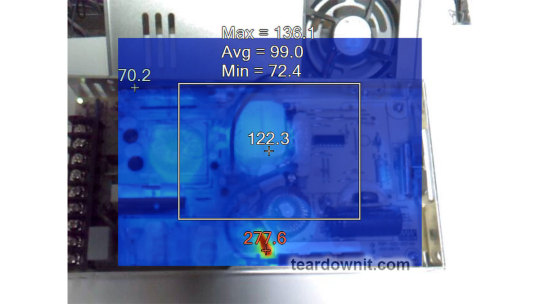
100% load
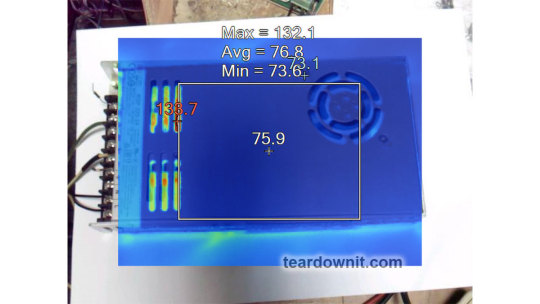
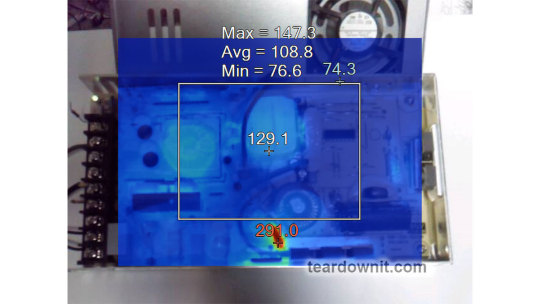
Conclusions
Overall, the RSP-320-24 is well-built: this power supply has good dynamic characteristics, low noise, and ripple, good accuracy in maintaining the output voltage, and is well put together. The load should be limited to 70–80% of the nominal for long-term operation.
Important: The results are valid for this particular power supply unit; they were obtained for testing purposes and should not be used to evaluate all the units of the same type.
0 notes
Note
AU where Jazz runs a TON of charge. It takes ten spike overloads to satisfy him, and he doesn’t have a refractory period. After ten overloads in a row, he tends to go utterly feral—as if he’s in rut. Just mounting and clawing and biting and rutting away until he finally knots his partner and blacks out. This is only occasionally a problem, because basically no one can handle getting him off ten times in a row anyway.
Prowl, SiC, sees how this endless charge is impacting Jazz’s work (and quality of life). He has a crush, but he tells himself that’s not his motivating factor. Jazz needs someone he can trust to see him to blackout. Someone who won’t tap out three overloads in. Someone who won’t judge him for getting increasingly desperate and feral and possessive as he frags them.
Jazz maybe thinks no one could tolerate that kind of behavior. He might feel ashamed of the fantasy he has of ruthlessly fucking someone completely helpless. Someone who trusts him. (Possibly someone who would trust him enough to knowingly drink drugged energon hand fed to them)
Fortunately for him, Prowl thinks that fantasy is HOT AS A SMELTER.
Time for Jazz to finally get some satisfaction.
Despite the war ravaging the planet, Cybertron was seeing a mixing of frametypes like never before. It was by in large a positive as cultures that once stood well apart rubbed one side by side. It was not entirely positive. The differing needs if frame types could class, as Praxian Prowl had experienced this firsthand but at the moment he was not worried about himself or his framekin. He was worried about Jazz.
As Praxus had segregated itself from its neighbours with the great dome, Polihex had itself been segregated, the nomadic and semi nomadic groups had roamed the Wastes and the Rust Sea without fear of heat or storms where no other frametype had. Their frames had developed their own quirks and one of Jazz’s was coming into play.
He needed to frag. But Jazz did not trust so much and so easily as mechanisms thought. Why anyone believed a spy would be trusting, Prowl could not begin to understand. There were Bots Jazz trusted, his team, of course but his team did not comprise mecha capable of taking what Jazz had to give them. He was starting go get snappy, standoffish. It was effecting moral, that seemed like a good excuse.
"You need to frag," Prowl declared as Jazz smacked the datapad he was fiddling with. The Polihexian's visor flashed white.
"Not really yer business, Prowl," he replied. Prowl flicked a single doorwing.
"It is affecting your productivity," Prowl said. "There is no way in Pit I will authorize your deployment when you are in such a state."
"Ya can't order me to frag," Jazz said. "OP would have yer helm."
"Why would I order you?" Prowl asked. "We both know how well you listen to my orders. I am offering my assistance."
"I would ruin ya in two overloads," Jazz said. "Not worth the effort."
"You will find I was forged for endurance," Prowl replied. "I could take anything you give and more."
Jazz stared at him and cocked his helm as he looked Prowl up and down. Prowl did not flinch from the hungry in the mech's expression. He had won, and he knew it. At the best of times Jazz was hard pressed to resist a challenge. This was far from the best of times.
"We'll see."
There was something to be said for Jazz’s self-restraint, he had more of it than anyone, including Prowl would have guessed. He did not push Prowl down on his desk and frag him, but made an honest to Primus appointment for the coming dark-cycle and suggested Prowl take them both off the schedule for the next mega-cycle. Prowl had never gotten so thoroughly fragged that he could not work the next mega-cycle but he acquiesced. It was not as if he could not put himself back on duty as it suited him.
They met in Jazz’s quarters rather than Prowl’s, though Prowl’s rank afforded him best quarters; he had never changed from the original suite he had been afforded as a tactical officer. All he used his quarters for was recharge and the narrow berth was adequate for that. That berth would not serve a marathon interface. Jazz’s would serve that purpose far better. Prowl was not clear of what expectations he had possessed prior to his arrival but every preconception fled as soon as he stepped through the door. That unexpected self-restraint he had observed in Jazz in the light-cycle was gone and as soon as Prowl entered, Jazz was there. Prowl gasped with start as Jazz effortlessly disrobed him.
“Nice tits.”
Servos cupping Prowl’s wells, Jazz pushed Prowl up against the wall and covered his mouth in a crushing grip. He hiked up Prowl’s leg, hooked it over his hip and shoved Prowl’s modesty panel aside as it was still retracting. Prowl moaned into the brutal kiss as Jazz’s ground his palm into his node as his digits spread his folds. The preparations were quick, rough and Prowl was at a loss to do anything but cling to Jazz’s shoulders. He was embarrassingly wet, just dripping with slick before Jazz’s digits ever entered him. His valve made an obscene squelch as Jazz digit-fragged him, spreading his too long empty lining. Apart from the squelch all sounds of Prowl’s overload were muted, swallowed by Jazz’s hungry mouth.
With the nip of his swollen lower lipplate, Jazz broke the kiss and stared into his glassy optics. Prowl dug his digits into Jazz’s shoulders as the other mech suddenly pulled his leg over his shoulder and drove his spike deep into Prowl’s frame. The speed and the force knocked the intakes from Prowl and the sudden stretch burned but along with the burn was a sudden scalding pleasure as his internal sensors and nodes were quickly triggered. It was embarrassing how quickly he overloaded, screaming Jazz’s designation, before Jazz had even sheathed himself in his quickly spasming valve. His leg, the one still on the floor felt like gel and he trembled. Before he could fall, before he could even secure his grip on Jazz’s shoulders, Jazz yanked that leg out from under him and held him up as he thrust up into Prowl’s valve, carving through his internal seal, carving him open. Prowl’s mouth fell open in a shocked O. His doorwings smacked back against the wall. Jazz groaned, denta clenched as he took his pleasure. Blistering hot transfluids flooded Prowl’s tank. He panted. That was one for Jazz. How many did a Polihexian usually have in a session? Oh yes, ten or twelve.
Jazz’s spike was already pressurized again before he pulled out of Prowl. He tossed the Praxian over his shoulder and carried he over to his berthroom. Prowl squeaked when he was tossed onto the berth. Flushing madly, he shuffled back so his helm rested on Jazz’s pillow, then through his legs open and canted his hips as he reached between his thighs and he moaned as he held the rim of his oozing valve open. When Jazz fell over him, Prowl cried out with ecstasy. Jazz held Prowl’s legs up and open as he filled him in one great plunge. He caught Prowl’s nozzle between his denta and nipped and sucked.
With his helm pulled back by the firm grip Jazz had on his chevron, Prowl grunted and panted as Jazz reamed out his aft pipe. He had always enjoyed aftplay and nothing at all had changed here. Prowl dug his digits into the blankets below him and he pushed back into Jazz’s churning thrusts. His wells, too large for his frame, swayed under him. Jazz covered Prowl’s long neck with denting bites. When Jazz pulled out, transfluids drooled Prowl’s slack rim. That was three.
“New ya’d have a tight aft,” Jazz groaned as he watched his spend leak out of Prowl’s afthole.
A mech possessed, Jazz gave Prowl quarter, there was no respite. Prowl braced himself on Jazz’s taunt belly as he rode the Polihexian’s spike. Jazz tugged and pinched Prowl’s nozzles. He was rough as he played with Prowl’s heavy wells and fragged up into Prowl’s well fragged core. As his node ground into Jazz’s array, Prowl round Jazz harder, faster. His glossa lulled from his mouth as he moaned deliriously. Jazz reared up, taking Prowl’s nozzle into his mouth again as his digits drove into his drooling afthole.Prowl’s optics crossed and he overloaded with a wail as Jazz’s splattered his gestation tank with more transfluids. That was... four? Five? Prowl had lost track already.
He was not sure if he was overloading anymore, or if he just never stopped. Prowl panted as he twisted the pillow under his helm in his servos. Another pillow was beneath his hips as Jazz pinned him down, servos folded over his shoulders and drilled him deep. Prowl moaned softly as Jazz ran his servos over his back and doorwings and squeezed his round aft segments. He sucked a denta into the edge of Prowl’s doorwings. Somehow, Prowl found the energy to wail as he overloaded. His protoform rounded slightly as Jazz released into his tank again. Prowl panted. He spent. Jazz rolled him and pushed his legs open. Jazz was not.
Jazz stood up on his knees and rutted into Prowl’s sloppy valve.The angle he was using dragged Jazz’s spike against Prowl’s gamma cluster and his internals clenched as sparks flew across his vision. HIs peds curled, Prowl reached between his own legs to furiously, rub his anterior node. With a shrilled shriek, Prowl overloaded but Jazz never stopped stimulating Prowl’s gamma cluster and soon Prowl was overloading again, his valve sprayed lubricants out around Jazz’s spike.
Prowl drooled against the pillow as Jazz crouched over his upturned aft and growled as he plunged his spike into Prowl’s quivering channel. His protoform was bloated, inflated with Jazz’s transfluids. It was going to take orns for the swelling to go down, Everyone was going to think he was carrying. Something heavy and solid ground against Prowl’s slack folds. The knot. He still needed to take Jazz’s knot. Prowl sobbed as the thick swelling at the base of Jazz’s spike butted against his rim. As it was, he was already so full. Overwhelmed, Prowl tried to wriggle away but Jazz bit his doorwing and hiked his hips up, and forced the knot passed the last of his internals’ resistance.
Jazz’s overloaded with a grunt, the force of his spill so much strong and the amount so much greater. Prowl dragged his servo under him and felt his swollen belly where he was inflated with Jazz’s spend. Groaning softly, Jazz collapsed against his back and his spike twitch with another spurt of transfluids as he fell into stasis lock. Prowl tried to push himself up, to get himself out from under Jazz but he was too tired to dislodge the mech. His optics grew dim and he resigned himself to recharging with Jazz pinning him to his filthy berth and his spike knot deep in his tank.
#valveplug#maccadams#ruination#tf prowl#tf jazz#come inflation#rut#challenge acceped#anon fic ask#anon asks ficlet#tasty tuesday
179 notes
·
View notes
Text
My Homelab/Office 2020 - DFW Quarantine Edition
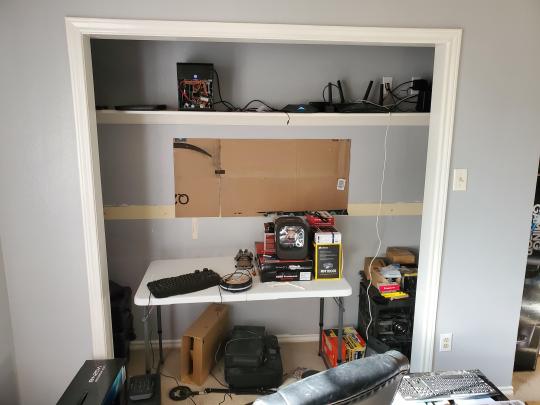
Moved into our first home almost a year ago (October 2019), I picked out a room that had 2 closets for my media/game/office area. Since the room isn't massive, I decided to build a desk into closet #1 to save on space. Here 1 of 2 shelves was ripped off, the back area was repainted gray. A piece of card board was hung to represent my 49 inch monitor and this setup also gave an idea how high I needed the desk.
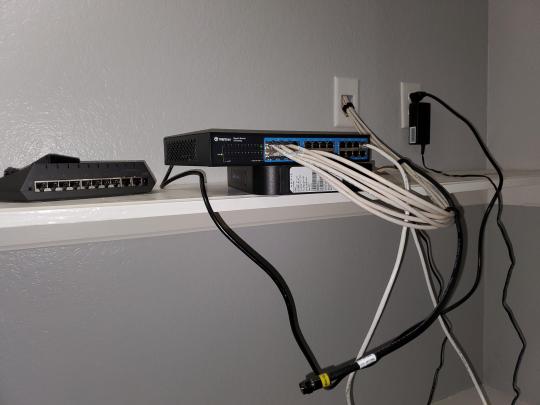
On my top shelf this was the initial drop for all my Cat6 cabling in the house, I did 5 more runs after this (WAN is dropped here as well).
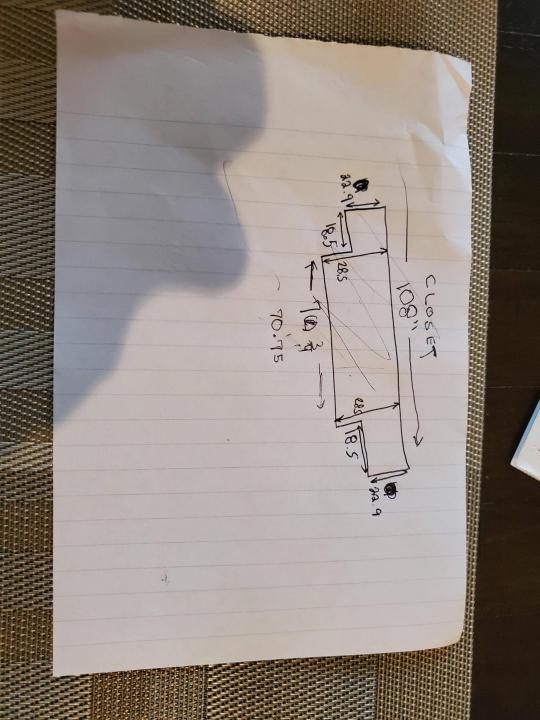
I measured the closet and then went to Home Depot to grab a countertop. Based on the dimensions, it needed to be cut into an object shape you would see on Tetris.

Getting to work, cutting the countertop.
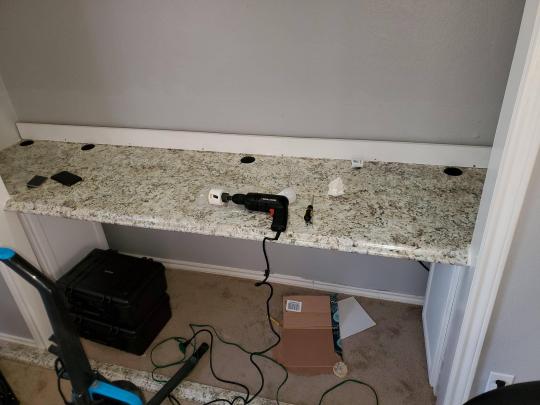
My father-in-law helped me cut it to size in the driveway and then we framed the closet, added in kitchen cabinets to the bottom (used for storage and to hide a UPS). We ran electrical sockets inside the closet. I bought and painted 2 kitchen cabinets which I use for storage under my desk as well.
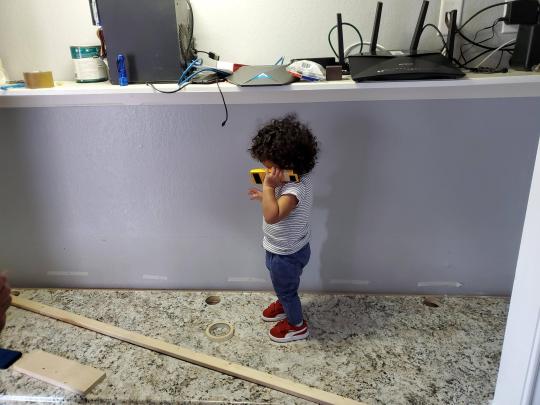
The holes allowed me to run cables under my desk much easier, I learned many of these techniques on Battlestations subreddit and Setup Wars on Youtube. My daughter was a good helper when it came to finding studs.
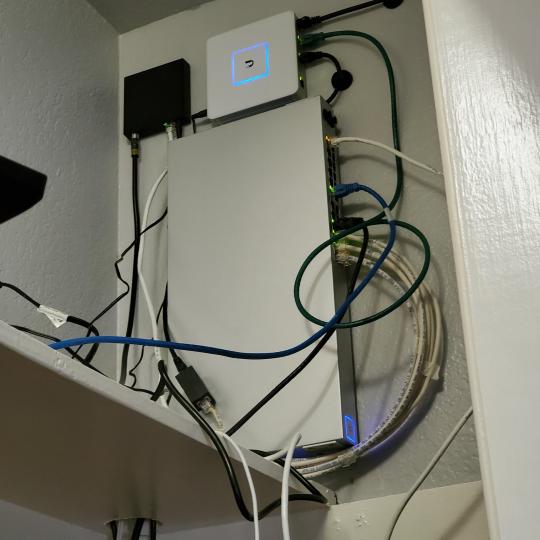
Some of my cousins are networking engineers, they advised me to go with Unifi devices. Here I mounted my Unifi 16 port switch, my Unifi Security Gateway (I'll try out pfSense sometime down the line), and my HD Homerun (big antenna is in the attic). I have Cat6 drops in each room in the house, so everything runs here. On my USG, I have both a LAN #2 and a LAN #1 line running to the 2nd closet in this room (server room). This shot is before the cable management.
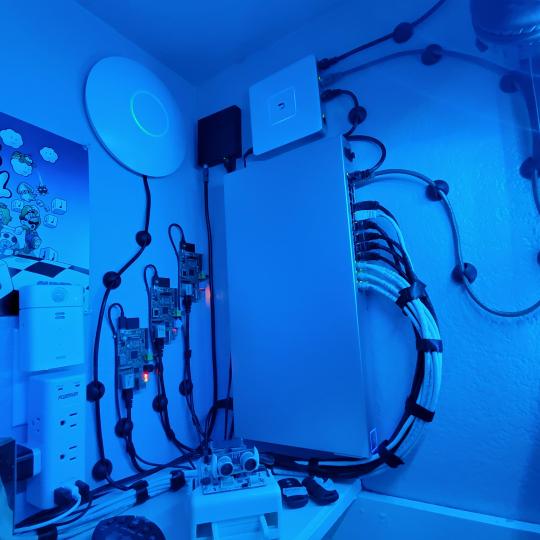
Cable management completed in closet #1. Added an access point and connected 3 old Raspberry Pi devices I had laying around (1 for PiHole - Adblocker, 1 for Unbound - Recursive DNS server, and 1 for Privoxy - Non Caching web proxy).
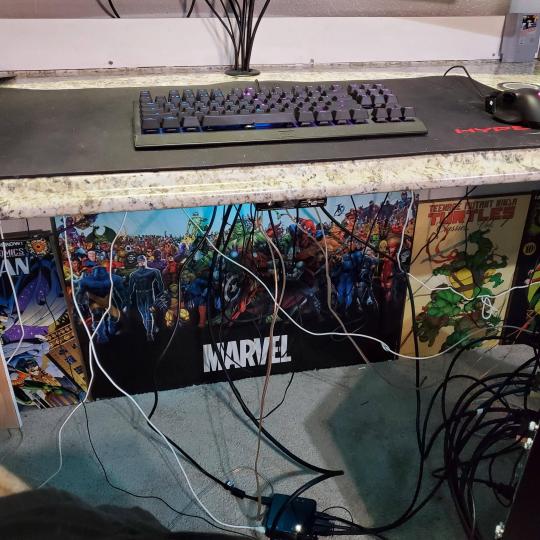
Rats nest of wires under my desk. I mounted an amplifier, optical DVD ROM drive, a USB hub that takes input from up to 4 computers (allows me to switch between servers in closet #2 with my USB mic, camera, keyboard, headset always functioning), and a small pull out drawer.
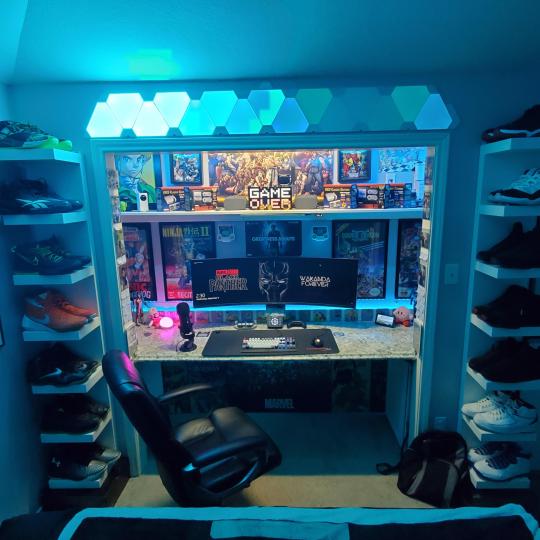
Cable management complete, night shot with with Nanoleaf wall lights. Unifi controller is mounted under the bookshelf, allows me to keep tabs on the network. I have a tablet on each side of the door frame (apps run on there that monitor my self hosted web services). I drilled a 3 inch hole on my desk to fit a grommet wireless phone charger. All my smart lights are either running on a schedule or turn on/off via an Alexa command. All of our smart devices across the house and outside, run on its on VLAN for segmentation purposes.
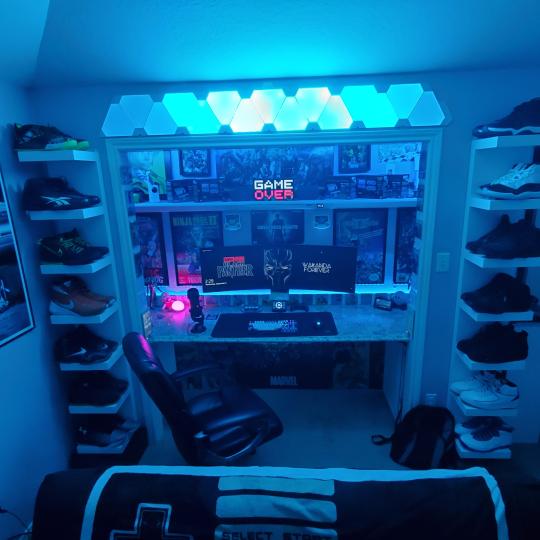
Quick shot with desk light off. I'm thinking in the future of doing a build that will mount to the wall (where "game over" is shown).

Wooting One keyboard with custom keycaps and Swiftpoint Z mouse, plus Stream Deck (I'm going to make a gaming comeback one day!).
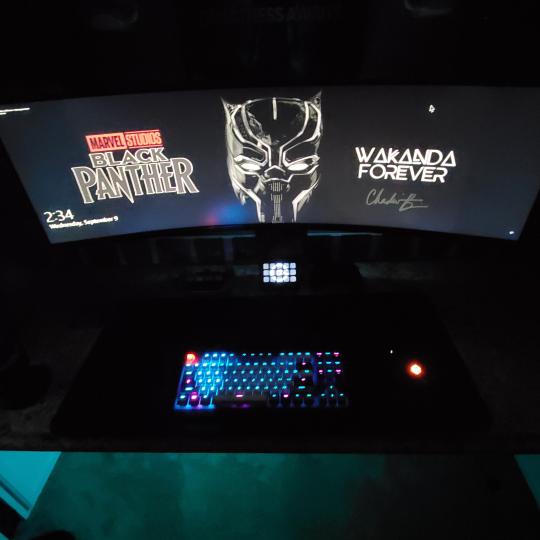
Good wallpapers are hard to find with this resolution so pieced together my own.
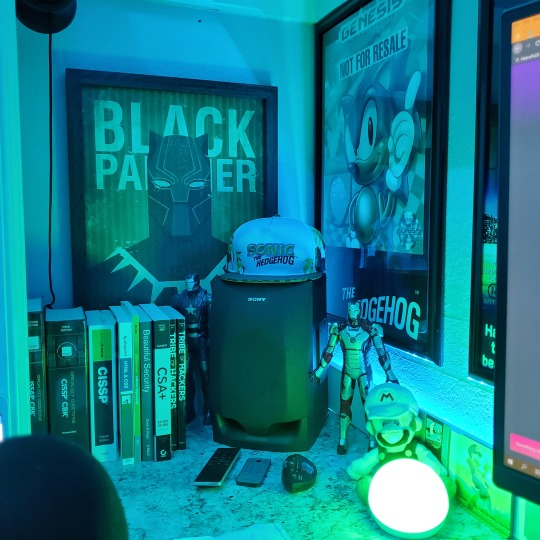
Speakers and books at inside corner of desk.
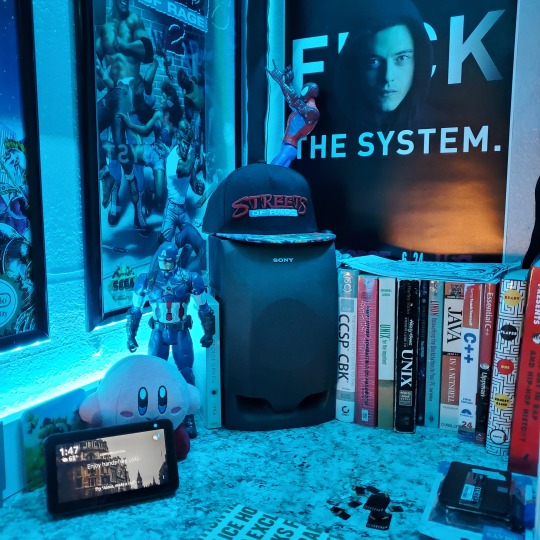
Speakers and books at inside corner of desk.
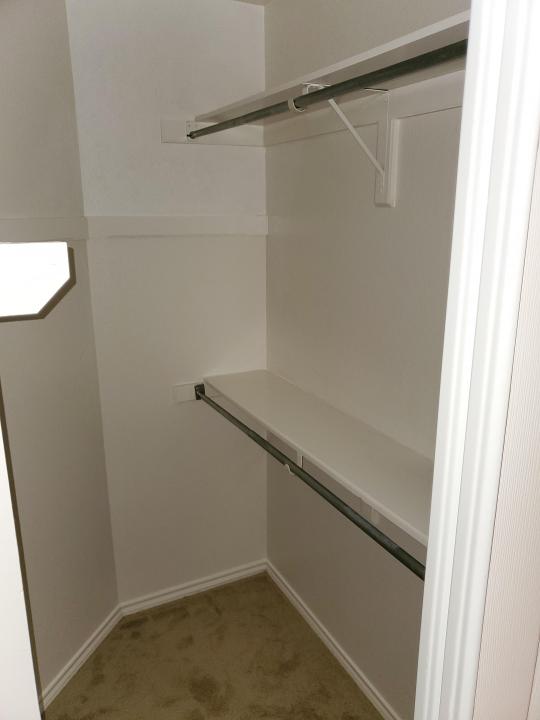
Closet #2, first look (this is in the same room but off to the other side). Ran a few CAT6 cables from closet #1, into the attic and dropped here (one on LAN #1, the other on LAN #2 for USG). Had to add electrical sockets as well.
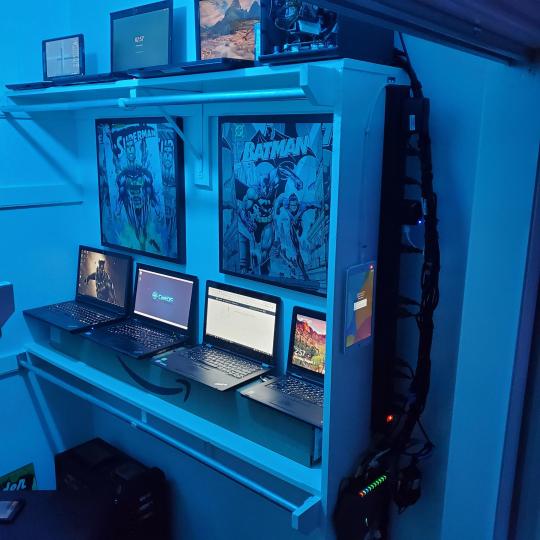
I have owned a ton of Thinkpads since my IBM days, I figured I could test hooking them all up and having them all specialize in different functions (yes, I have a Proxmox box but it's a decommissioned HP Microserver on the top shelf which is getting repurposed with TrueNAS_core). If you're wondering what OSes run on these laptops: Windows 10, Ubuntu, CentOS, AntiX. All of these units are hardwired into my managed Netgear 10gigabit switch (only my servers on the floor have 10 gigabit NICs useful to pass data between the two). Power strip is also mounted on the right side, next to another tablet used for monitoring. These laptop screens are usually turned off.
Computing inventory in image:
Lenovo Yoga Y500, Lenovo Thinkpad T420, Lenovo Thinkpad T430s, Lenovo Thinkpad Yoga 12, Lenovo Thinkpad Yoga 14, Lenovo Thinkpad W541 (used to self host my webservices), Lenovo S10-3T, and HP Microserver N54L
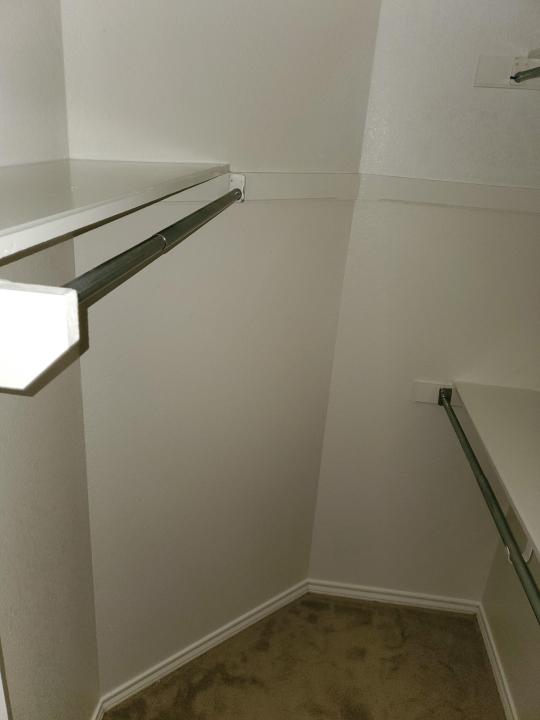
Left side of closet #2
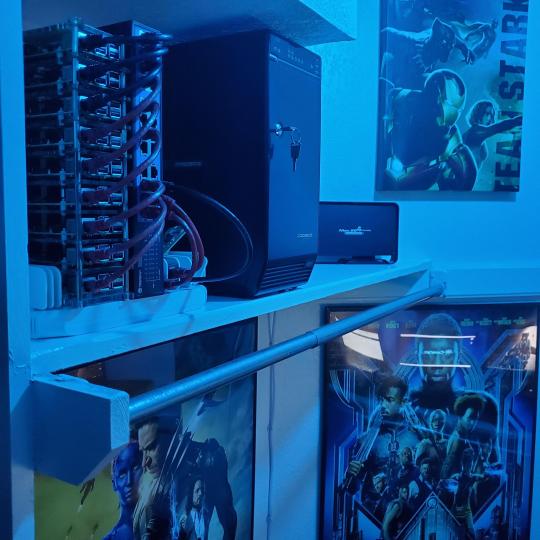
**moved these Pis and unmanaged switch to outside part of closet**
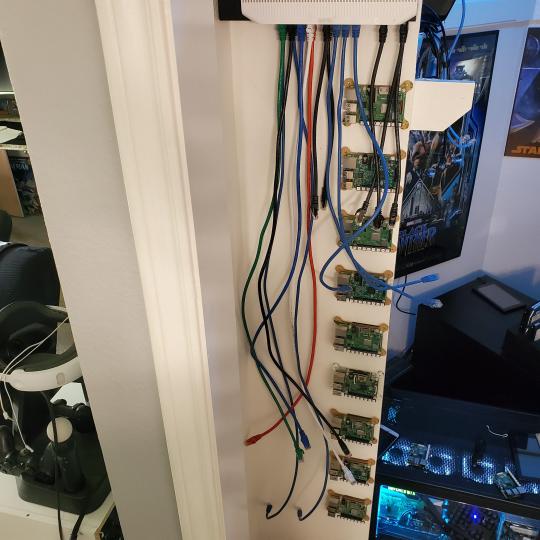
Since I have a bunch of Raspberry Pi 3s, I decided recently to get started with Kubernetes clusters (my time is limited but hoping to have everything going by the holidays 2020) via Rancher, headless. The next image will show the rest of the Pis but in total:
9x Raspberry Pi 3 and 2x Raspberry Pi 4
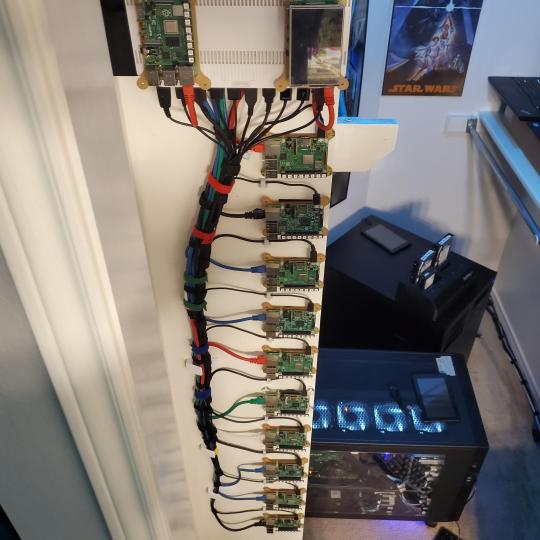
2nd shot with cable management. The idea is to get K3s going, there's Blinkt installed on each Pi, lights will indicate how many pods per node. The Pis are hardwired into a switch which is on LAN #2 (USG). I might also try out Docker Swarm simultaneously on my x86/x64 laptops. Here's my compose generic template (have to re-do the configs at a later data) but gives you an idea of the type of web services I am looking to run: https://gist.github.com/antoinesylvia/3af241cbfa1179ed7806d2cc1c67bd31
20 percent of my web services today run on Docker, the other 80 percent are native installs on Linux and or Windows. Looking to get that up to 90 percent by the summer of 2021.
Basic flow to call web services:
User <--> my.domain (Cloudflare 1st level) <--> (NGINX on-prem, using Auth_Request module with 2FA to unlock backend services) <--> App <--> DB.
If you ever need ideas for what apps to self-host: https://github.com/awesome-selfhosted/awesome-selfhosted
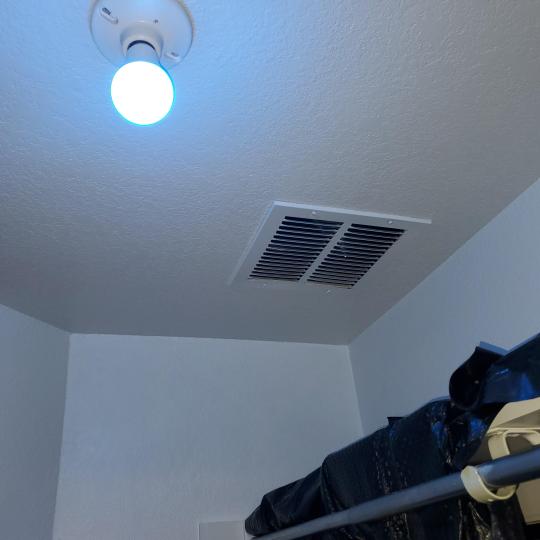
Homelabs get hot, so I had the HVAC folks to come out and install an exhaust in the ceiling and dampers in the attic.
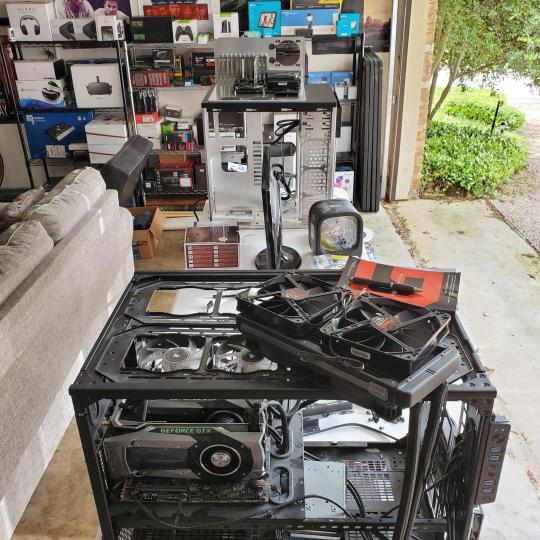
I built my servers in the garage this past winter/spring, a little each night when my daughter allowed me to. The SLI build is actually for Parsec (think of it as a self hosted Stadia but authentication servers are still controlled by a 3rd party), I had the GPUs for years and never really used them until now.
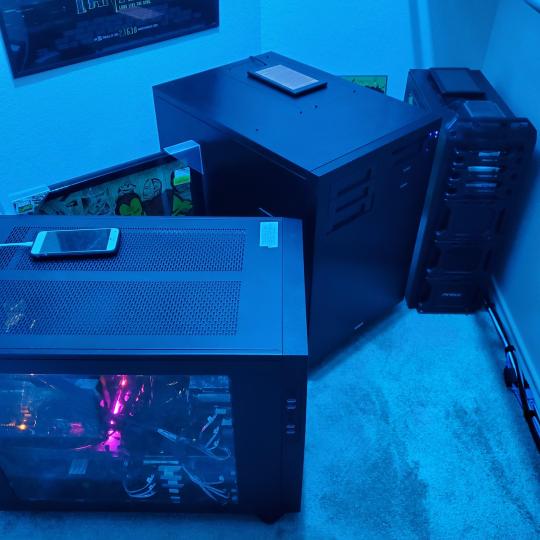
Completed image of my 2 recent builds and old build from 2011.
Retroplex (left machine) - Intel 6850 i7 (6 core, 12 thread), GTX 1080, and 96GB DDR4 RAM. Powers the gaming experience.
Metroplex (middle machine) - AMD Threadripper 1950x (16 core, 32 thread), p2000 GPU, 128GB DDR4 RAM.
HQ 2011 (right machine) - AMD Bulldozer 8150 (8 cores), generic GPU (just so it can boot), 32GB DDR3 RAM.
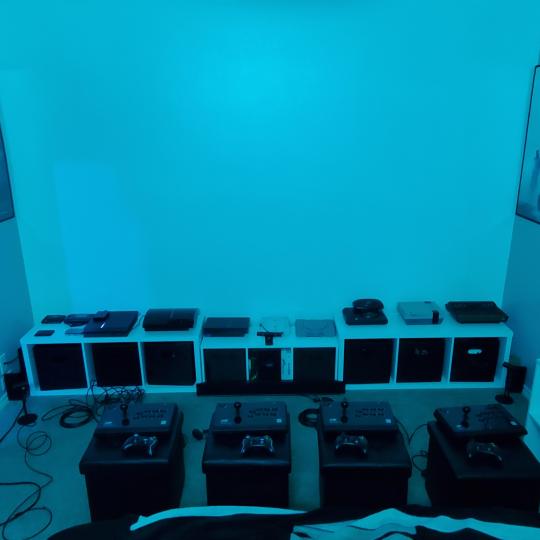
I've been working and labbing so much, I haven't even connected my projector or installed a TV since moving in here 11 months ago. I'm also looking to get some VR going, headset and sensors are connected to my gaming server in closet #2. Anyhow, you see all my PS4 and retro consoles I had growing up such as Atari 2600, NES, Sega Genesis/32X, PS1, Dreamcast, PS2, PS3 and Game Gear. The joysticks are for emulation projects, I use a Front End called AttractMode and script out my own themes (building out a digital history gaming museum).

My longest CAT6 drop, from closet #1 to the opposite side of the room. Had to get in a very tight space in my attic to make this happen, I'm 6'8" for context. This allows me to connect this cord to my Unifi Flex Mini, so I can hardware my consoles (PS4, PS5 soon)

Homelab area includes a space for my daughter. She loves pressing power buttons on my servers on the floor, so I had to install decoy buttons and move the real buttons to the backside.
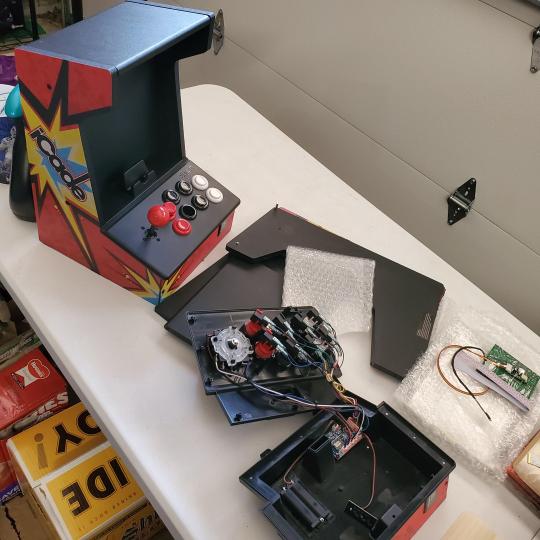
Next project, a bartop with a Raspberry Pi (Retropie project) which will be housed in an iCade shell, swapping out all the buttons. Always have tech projects going on. Small steps each day with limited time.
6 notes
·
View notes
Text
White, Gold and Blue
Will you haunt me?
Security node active, I got a faint view of what happened after my black out. Hands bound, weapons taken and loaded into a transport vehicle, the view keeps cutting out, and the rest of it is in the dark.
“Wake him up.” A voice echoed in my audio sensors as I felt a stab in my neck. A flood of nanomachines into my system, bringing it back to life as my vision calibrated to the lights above me. Gyroscope within my head spooling up, I pulled my head up and focused on the view ahead. A woman with white hair and glasses pinned over her eyes, a folder before her as she opened her voice and turned the first page of the folder. Silence, no words from her nor anywhere else, I opened my comlink and attempted to reach Valkyrie. Her transponder was there, but the walls were blocking the radio signal from passing through.
“Your name?” The woman asked, tilting the folder towards her to reveal the covers, my name written across them along with several stamps informing that the info was confidential. Silent, keep my cards hidden for now.
“Hmm…” She sighed and scribbled something on the page.
“Your designation?”
“ZX-15” Another scribble on the page, she kept one eye on me as if she was careful even though my hands were mounted to the desk with no chance in getting out without the keys.
“What is your mission?”
“Data erased/Unknown.”
“When did you arrive?”
“4 hours ago.” A guess as I had no idea when the ship had landed here, a faint signal passing through the air.
“What ship did you arrive on?”
“Name unknown, Corporation fleet carrier.”
Closing the folder, she got up from her chair and walked over to the door. The signal passing over grew stronger as I realized it wasn’t coming in, but going out. Whoever was listening was hearing the same answers as she was.
“Thank you for your cooperation.”
The door slid open; she stepped out into the hallway as I was left alone. Arms across the table, I saw the armor plates from them missing as the blade within was covered with a cover along its edge to prevent its use. They knew what they were doing, that’s for certain, but do they know who I am?
Hard to triangulate a signal when you don’t see the other points, I kept my scanners active as the woman returned with a guard standing behind her. He walked next to the desk and unlocked the cuffs from the desk, allowing me to stand up.
Light armor from head to toe, a blue triangle on his helmet as he stood me up and guided me out of the door. Fighting this is not a good idea, no weaponry to speak off and the lack of armor would leave me dead before I could free myself from these cuffs. Following along, I could hear the signals again. Valkyries transponder was close, but attempting connection, a firewall barricaded me from reaching her. Hold strong, I won’t leave you.
Through the hallways, I was taken into a room covered in sensors and projectors. The soldier told me to enter and connect myself to the system via the wires hanging from the ceiling. Closing the door, he opened a small hatch to remove my cuffs, a code entered via a key; they sprung open like a bear trap. Free from my restraints, I played along to see where it would lead me, the cables connected to the back of my head as the view before me changed. Pillars across the sides and a light breeze of the wind, I felt calm as a door formed in front of me, a soldier in fancy gear opening it up as a fanfare played in the background. Nice and all, but all theatrics, I walked through the doors and found myself before a throne. Long brown hair, a dress of white, gold and blue.
“I trust you know of me?” She said,
“Unfortunate, but no.”
“Hmm, we must rectify this matter.” She stood up and placed one hand on her chest.
“I am Queen Alina Lillya, The current Emperor and the guardian of the skies above. I know of you and your feats, no matter how destructive they are.”
“Word gets around; can you trust all of it?”
“Of course not, that is why I have taken time to organize this meeting. I’ve heard one side, I wish to hear the other.”
“Before I tell you, I wish for you to release my companion.”
“She will be held for questioning for now, but I’ll see what I can do.”
Stories of the past, displayed from my view and the security footage recovered from different sites, I kept an eye on show she reacted to them. Her subordinates reacted more than she did.
“I’ve seen enough.” The footage stopped as she sat back down and looked at me, I could feel the lightly yellowish eyes boring right into my system as the connection started to close out.
“Good luck, my ghost.” Echoed through my audio systems as the connection ended, I removed the cable from the back of my head as the door was opened again.
The Queen has met the Jack.
2 notes
·
View notes
Text
Automated Blinds In Coquitlam: Top 3 Things To Consider

With the increasing popularity of home Automated Blinds in Coquitlam and the number of Smart gadgets such as speakers, sensors, etc., in-home automation of window coverings has become a typical question for customers. Consider these 3 things before making a decision.
Home Automation and the advancement of various devices like speakers, sensors, and so on have triggered a surge of interest in automated window coverings. Many customers prefer automated blinds for the ease of voice-control, remote access, hassle-free operation etc.
Generally, there are three factors to consider when choosing a custom automated window blinds setup:
1. Automation need
2. Choice of window covering
3. Integrating the system
1. Automation need
While it can be amazing to presume that I can have full control of all the shades and draperies in my home by lifting apart a wall-mounted remote control or hailing my smart speaker with my simple name, this is not a practical solution in the long run, as I will discover after purchasing several sets of custom-made drapery control for each pane of glass.
Instead of focusing on windows that they ought to automate, you could instead focus on windows which represent the maximum benefit.
Common things to consider :
• Can the window be opened?
Is the window too narrow, such as, for example, large windows that require them to be pulled back by levers or rods somewhat? Or tall windows.
• Are there scheduling times that describe how you need to operate the window treatments? For example, is it necessary to close the shades before leaving for work?
• Am I going to need to oversee multiple windows in a room to achieve the desired atmosphere?
• Do my home automation system include controls to control shades drapery?
2. Window covering choices
When researching which windows to have automated shades or drapes installed, consider the type of product you'd like for the windows.
Products are specified for shading, privacy, outside appearance, and design to create a variety of light environments in a room with multiple windows. You may need to address multiple window coverings at once to control the quantity of light inside the room appropriately. In some cases, a window shading or drapery may require a 3rd position besides full open or fully close.
Manual guidance of 1 or 2 shades can be a better option in many instances, however, in rooms with several windows, centralized control of shades may be more beneficial. With a motorization update from a specialist like us, you can get the results you want at a sensible rate with long-term quality in mind.
3. Integrating systems
With new competing products in the market, there are no front standards. The technology used in automated window coverings (blinds and curtains) must remain future-proof, trading standard apps for home automation that control light, music, security, garage door, and window covering can be used if the home has this degree of automation and lights, curtains, and accessories can be controlled by a single app.
Integrating Technologies
Our products fully integrate with a variety of different third-party technologies.
Radio Technology Somfy® (RTS): Programmable motorized systems can be controlled via a wireless radio via the RTS family of controls.
Somfy Digital NetworkTM (SDN) A control method that uses a two-wire bus is RS485.
Z-Wave R: It is a wireless, 2-way RF networking technology used in both residential and office automation applications.
Zigbee Protocol: An RF mesh networking technology that relies on 2.4GHz nodes is used for commercial and residential applications.
Third-Party Automation Systems
Our expert technicians can mount your home automation system of choice, whether it be Crestron, Control4, or Amazon Alexa. We can also ensure that your motorized window coverings work with your system of choice.
Whether it's high-end home automation systems such as Crestron or Control4 or the latest consumer-grade wireless solutions such as Amazon Alexa, we can assure you that contemporary mechanized window treatment product integration can occur using the system of your choosing.
Conclusion
Each protocol and communication standard has its proponents and supporters. The reality is that there’s no way of knowing which technology or standard will prevail.
Even if you are inclined to use a skeleton-like controller with switches and remote controls to control safety concerns in your window coverings, you need to learn of the broader products that may make your motorized window treatments more stable. When you are choosing motor brands that are large enough for your blinds, shades or draperies, you should seek out motor manufacturers that are standard brands. Famous companies use proprietary processing techniques that do not work out across multiple platforms. This article was originally posted on: https://sunblinds.ca/vancouver/automating-your-blinds/
0 notes
Text
Interaction Design Experimental
If we were to run a design lab, it would explore ways to interact with digital and physical products, for state-of-the -art accessibility and pleasure.
Hers a list of projects we have worked, thought or imagined through the years:
- CD Player: A pure, minimalist home CD player with attractive aesthetic to fit millennials and audio purists homes. Ecosystem of products to follow it like wall mounting assembly, CD storage shelves, remote control or mobile app. Physical controls, knobs and possible a high quality screen.
- Tangible Smart Home: A universal knob to control smart home appliances designed for inclusivity with visually impaired people at the center. New appliances lose their traditional tangible controls for flat touch panels making it hard for people with visual disabilities to control them. Bosch’s Home-Connect offers developers API to control a big ecosystem of their devices giving the possibility for tangible interfaces to be designed to enable access from wider audience.
- Artful Capsule Coffee Machine: A tangible easy to use capsule coffee maker, with uniquely formed curves inspired by automotive classics. Designed with petrolheads and art collectors in mind, to be the center of attention in social gatherings. CNC Aluminum form, tangible interactions, ability to carry on special leather bag, refillable capsules and water tray.
- R-Node: A smart ring for monitoring Raynaud’s syndrome. With thermistors and BLE it should enable biofeedback sessions to train patients learn more for their chronic syndrome. It can allow tap interactions on the physical ring.
- Cruciate Ligament Training Band: An interactive band worn at the leg with suffering from cruciate ligament injuries sending biofeedback to a mobile app. Allows patients execute training sessions under surveillance and monitor their healing progress.
- Digital Compass for VIP: A tangible navigation tool that helps people with visual impairments (VIP) guide themselves in modern smart-enabled cities. Reads GPS and BLE signals from around and can enhance the experience with digital compass sensor when its safe from interferences. Can be adjusted for hikers who want to keep their eyes on the trail.
- Lè Candle: Natural source of light, benefits of fire, full spectrum. Imagine using candles as a primary source of lighting for home in the 21st century. Digitalized, switch and remote controlled, fully safe, sustainable and fair-trade wax and consumables.
(my notes)
0 notes
Text
Industrial IoT Devices | Programmable Ethernet IoT Device | Industrial ESP32 | NORVI
Ready for the Future - NORVI IIOT
Programmable IoT Devices - Our Arduino based PLC s make it easy to automate processes, connect sensors, and create sophisticated automation systems. Get the most out of your IoT projects with programmable ESP32 Ethernet device. Our MQTT end device is designed to be easy to setup, while providing powerful performance.
Industrial Arduino Mega - Get reliable, secure, and customizable control of your industrial processes with Arduino Mega PLCs. Get the best out of your system. Industrial Arduino for Automation Applications which control industrial processes with Arduino based hardware and software. Programmable with Arduino IDE.
Modbus MQTT Device - NORVI Agent Industrial IoT Node. Ready to use IoT Node. Ready for industrial applications. WiFi LoRa NB-IoT. Wall mount IoT node is designed for industrial applications and boasts a range of features including WiFi, GSM, LTE and LoRa connectivity. Battery Powered IoT node with WiFi GSM LTE LoRa connectivity for industrial applications. Our programmable nodes are designed for powering your IoT solutions.
ModBus RTU ESP32 - MODBUS Communication on ESP32 NORVI IIOT via RS-485. ModBus RTU with ESP32 based industrial controller. MQTT over Ethernet devices - Norvi offers programmable MQTT devices come with a variety of features that make them suitable for industrial automation and IoT solutions. As a leading industrial IoT device manufacturer, NORVI Offers Industrial Controllers for IoT applications, ESP32 based Industrial Controllers, Industrial IoT Devices. Changing IOT One Device At A Time (4 - 20mA, 0 - 10V DC Analog inputs and Outputs). Programmable controllers with flexibility and open source software.
ESP32 Data Logger - NORVI can build a WiFi Data Logger using SD card, Combining few libraries of Arduino you can access or view the Temperature & Humidity via WiFi. NORVI's Analog Input ESP32 is designed for industrial applications, allowing you to measure and monitor 0-10V or 4-20mA signals using an ESP32 controller.
NORVI Controllers
Our Address :
ICONIC DEVICES PVT LTD
Phone : +94 41 226 1776 Phone : +94 77 111 1776
E-mail : [email protected] / [email protected]
Web : www.icd.lk
Distributors
USA
Harnesses Motion LLC
1660 Bramble Rd. Tecumseh, MI
49286, United States
Phone : +1 (734) 347-9115
E-mail : [email protected]
EUROPE
CarTFT.com e.K.
Hauffstraße 7
72762 Reutlingen
Deutschland
Phone : +49 7121 3878264
E-mail : [email protected]
Products :
ESP32 Ethernet Device
Industrial Arduino Mega
ESP32 Modbus device
Programmable sensor node
Battery Powered Programmable Sensor node
4 - 20mA ESP32
Know More About:
WiFi Datalogger
4 - 20mA Arduino device
Industrial IoT Devices
Modbus MQTT gateway
Arduino based Industrial Controller
#Programmable IoT Devices#Industrial IoT Devices#Industrial Arduino#Arduino PLC#ESP32 Ethernet Device#Programmable Ethernet IoT Device#MQTT End Device#Industrial Arduino Mega#Arduino Mega PLC#Arduino based Industrial Controller#Programmable MQTT Device#Modbus MQTT Device#ESP32 Modbus device#Wall mount IoT Node#Wall mount sensor node#Programmable sensor node#Wireless sensor#Battery Powered IoT Node#Battery Powered Programmable Sensor node#Solar powered sensor node#MODBUS RTU ESP32#Modbus to IoT gateway#Modbus MQTT gateway#Programmable MQTT devices#MQTT over WIFI devices#MQTT over Ethernet devices#Industrial IoT device manufacturer#0 - 10V Arduino device#4 - 20mA Arduino device#ESP32 data logger
0 notes
Text
What is beacons?
Technology enables us to interact with various activities each day without even questioning. I.e., when turning on a car, through flipping on a switch to turn on light bulbs, and when a Wi-Fi signal promptly enables internet browsing. These simple things become connected through a technology called Bluetooth Beacons. In this article, we will discuss the basis of beacons and beacon technology, what beacons are used for, how to make a beacon structure, how they differ from Geo-fencing, and how they can be used concurrently with mobile apps.
What is beacon?
A Beacon is a small device comprising insignificant amounts of data that often transmit radio signals to nearby smart phones and tablets. The time between each movement sent and the signal strength is configured to draw the wanted coverage. Mobile apps are used to snoop the signals broadcast, where they trigger an action on the phone anytime they hear a relevant alert. Beacons can only disclose information to the phone but cannot read; hence they operate in one direction. Most of the data transmitted through current beacons does not change frequency as it is usually hard coded. Once it is set when configuring, it relies on a device that listens to do something intelligent with the information. With the advancements in technology, this is likely to change in the future.
How far do beacons reach?
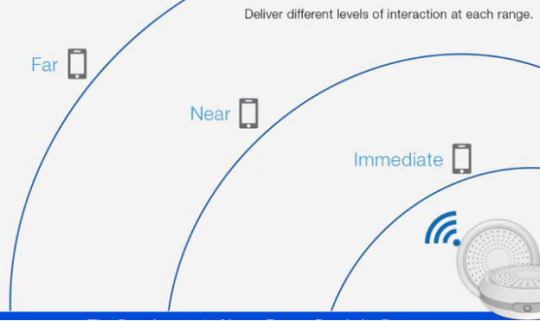
Though Beacons can have up to a range of 70m without any obstructions, walls made of bricks and metals can drop the coverage significantly. Thin stud walls have fewer minor effects. Most beacon portal operates with three distance ranges in which the device does different things with each range. They include;
· Far range distances – They are specially made such that your device can do something when close to hear a beacon, i.e., after walking past a retail shop.
· Near range distances – They are designed to operate when the device is in the same room with the beacon, i.e., walking into a retail shop.
· Immediate range distances– They are made to function once the device is almost close to touching a beacon, i.e., touching the point of sale in a retail shop.
Beacon packet
A beacon packet is the continuous transmission of signals in a beacon network that advertises the base station's presence. It persistently signals any fault condition in a nominal ring network such as FDDI. A beacon packet enables network administrators to pinpoint any faulty node in the system.

Beacon frame
It is a management frame category that detects a basic service set (BSS) designed by several 802.11 devices. A beacon frame comprises network data required by a station before transmitting a frame. Beacon frames are used to synchronize devices and announce the existence of devices in a WLAN connection.
As beacon frames are part of the basic service set, they are also wireless router access points that form the base stations for access. Communication through devices occurs with each other through access points where the beacon frames are periodically transmitted. This enables the devices connected to identify the position of the network channel. Independent basic service sets communicate to other devices based on peer-to-peer, allowing the beacon generation to be distributed among the connected devices effectively. It consists of the body, the IEEE 802.11 MAC header, and a Frame check sequence.
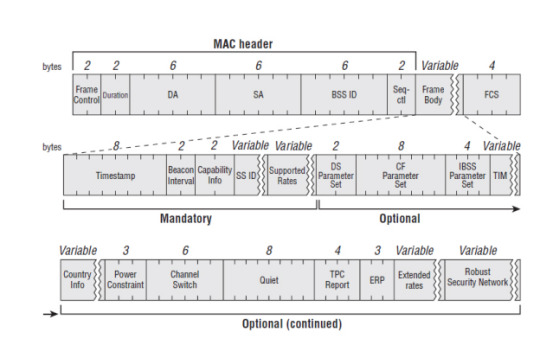
The body of a beacon frame has other vital fields, which include;
· Timestamp − It is the period with which a frame is directly associated with the beacon portal. A timestamp synchronizes a device while in the WLAN connection. It also helps the device to update its local clocks.
· Beacon interval – It is the time recess amid two repeated transmissions.
· Capability information − It comprises all data regarding the ability of the network. The capability information determines if the network used is ad hoc or infrastructure-based.
· SSID – It identifies the service set for networks.
· Supported rates − It expresses the speed of transmission acceptable by the channel.
· Frequency-hopping Limit Set
· Direct-Sequence Limit Set
· Contention-Free Limit Set
· Traffic indication map − It is an electronic image used in IEEE 802.11. A traffic indication map is periodically sent by the access point where it must pay attention to at least one beacon all through the beacon interval.
Types of Beacon protocols
a) Apple Beacon
Apple announced its first beacon protocol, iBeacon, in December 2013. It works with Google's Android and also Apple's iOS. This beacon uses the iBeacon protocol to transmits UUID that has a string of 24 numbers. The UUID communicates with a Mobile App installed.
Pros:
1. Broadly supported
2. Implementing Apple Beacon is easy and simple
3. Consistent performance while working on iOS.
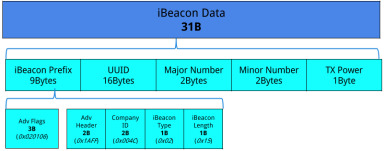
b) Eddystone (Google)
Eddystone was announced in the market by Google in July 2015. Initially, Eddystone was known as Uri Beacon. Beacons that Eddystone supports are specially made such that they can transmit three different frame-types. Eddy stone perfectly functions with both Apple's iOS and Google's Android. A single beacon has enough strength that can send all three Google Eddystone's frame types. The three frame types of Google's Eddystone are:
1. URL - It is a website link transmitted to the device, eliminating the mounted Mobile App's prerequisite.
2. UID – It is similar to Apple's UUID, but UID has a string of 16 numbers that identifies an individual beacon. A UID can efficiently activate an installed Mobile App.
3. TLM – This beacon frame type communicates administrative and sensor data through telemetry.
Pros:
1. It sends out an URL that removes the need for telemetry information and installed mobile apps.
2. Flexible to open and format.
3. Can easily integrate with Google Products.
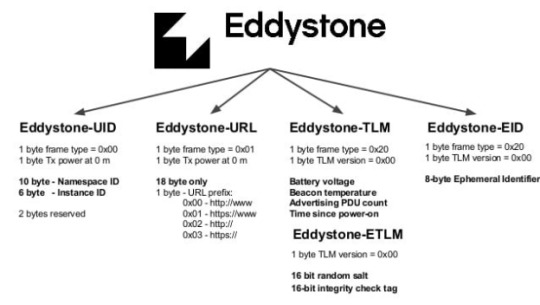
c) AltBeacon
AltBeacon was introduced into the market by Radius Networks in July 2014. The main aim of announcing this open-source beacon protocol was to help overcome the protocols that favor one vendor.
Pros:
1. AltBeacon is an open-source beacon protocol.
2. It is compatible with other mobile operating platforms
3. It is more flexible when using a customizable source code.
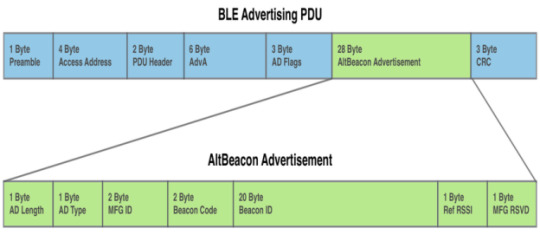
d) Geo-Beacon
GeoBeacon was announced into the market by Tecno-World in July 2017. Due to its compact type of data storage, the GeoBeacon open-source beacon protocol is specially designed for Geocaching applications.
Advantages:
1. This beacon protocol is open-source.
2. It is compatible with other mobile operational platforms.
3. Its coordinates are of high resolution.
4. It uses 8 bytes of user data.
Types of power solutions
Power solutions are of 3 types. They are;
1. Battery-powered beacons that use AAA, AA batteries or coin cell batteries.
2. Electricity plug-powered beacons.
3. USB-powered beacons.
Types of location technology
Most beacons apply Ble Beacon technology solutions to effectively communicate with other devices, which is effective as it retrieves the data location. However, besides Bluetooth technology, other location technologies exist in the market. They include;
a) Bluetooth low energy (Ble Beacon technology solutions)
Most beacon location technology relies on Bluetooth low energy technology. Compared with the classic Bluetooth technology, the BLE technology has a lower range, consumes less power, and transmits less data. The Bluetooth low-energy technology is specially designed for sporadic transmissions of minimal amounts of data.
b) Wi-Fi Aware
The Wi-Fi Alliance announced Wi-Fi Aware in July 2015. It is specially made for indoor locations. The rate of power consumption of Wi-Fi Aware is lower in comparison to regular Wi-Fi.
c) Combined technologies
Rather than focusing on merely one beacon technology, most vendors combine several location technologies.
How Do Beacons Work?
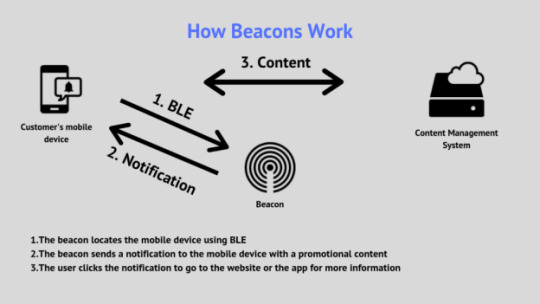
Any signal transmitted by a Beacon has a unique identification number that enables the data Centre (Content Management System) to fathom which device’s content needs to be pushed. These applications on beacon technology are developed so that they suit the requirements of the business.
Beacons are responsible for pushing all the content found on the CMS to the mobile devices by beacons, allowing change of content at any particular time. This is because data is stored in the cloud and not in the application. iBeacon, a protocol developed by Apple, is used to communicate, making it possible to transmit small amounts of data. Also, Google has developed Eddystone, which is an alternative to iBeacon.
Communication in these devices happens through Bluetooth Low Energy, a power-efficient disparity of the Standard wireless Bluetooth. The BLE technology enables beacons to work for almost 24 months using a coin cell battery. Most modern portable devices such as smart watches, smartphones, and tablets are installed with BLE chips.
The mobile phone is the last element in this chain. It receives contents in the form of notifications from the beacon. Customers are always directed into the seller’s application whenever they click on it. In case the device has no application installed, the customer can use the web to view the content.
Beacons Communication Mode
For effective communication, beacons use the Consultative Committee for Space Data Systems (CCSDS). The (CCSDS) telecommunications service is also used in the uncommunicated spacecraft through the deep space network. It is mainly designed to transmit the spacecraft's telecommunications status and its health information. It uses a simple signal that is easily detectable with a moderately-sized projection. Also, the beacon mode permits spacecraft to link with each other daily, letting one spacecraft to performance as an information proxy for the other.
The CW tone is transmitted using the CCSDS tone beacon mode that configures the transceiver. Besides, it is used as an indicator for other spacecraft when transferring data to an artificial satellite. However, its crucial role is to convey the health information of spacecraft. While using the four exceptional CW frequencies with 16 probable tones, it can address multiple spacecraft. UHF frequencies cannot be used in the outer solar system, but instead, the required technique is transmitted through a programmed backup transmitter. Outside the beacon mode service, spacecraft can retort to any transmit configurations that are compatible within force artificial satellites.
What data do beacons send to phones?
Beacons never convey any significant data. Alternatively, they convey short identifiers where the mobile app makes good use of the data sent and does something useful. For instance, the mobile app detects a broadcast of short numbers using a beacon, then converts the numbers into messages after connecting to the internet. Later, it triggers a push note to the receiver. With no internet, beacons can also send push notes but only of those with short characters. In short, beacons are replica devices that publicize temporary identifiers.
Theoretically speaking, beacons transmit an insignificant amount of customizable data and less data comprising a unique identifier. The identifier notifies the mobile app to twitch listening and does something that gives extra information for processing. The identifier is made of three parts; a "UUID," which is the identification document of the beacon vendor, and a "Minor" and "Major" identification documents, which are made to indicate different regions. All the data transmitted is unencrypted in a broad publicized format. This ensures there is standardization between platforms and manufacturers. To ensure that there is nothing sensitive transmitted over BLE, mobile apps should first understand this feature.
Can beacon work without an app?
An app must be configured to a particular beacon, although some transmission modes are specific to certain manufacturers. All beacons convey data using the same setup; hence they are interchangeable. For the mobile app to respond as planned, it must identify the beacon it is listening to; every beacon manufacturer has a set of tools available to assist in this process.
What can I track with beacons?
With the evolution of the Bluetooth Low Energy beacon technology, new and innovative ideas have been set by service contractors. This influences the aptitude to track people and assets at service locations and in workplaces. Beacons are used in numerous diverse surroundings in which security workers and janitorial operate. Some of the items trackable by beacons are;
· Roaming of mobile devices.
· Proximity detection of roaming assets.
· Fixed BLE receivers tracking
· Piggy-backing off the location of a mobile device.
· Augmenting a BLE solution with GPS, Geo-fencing, or Wi-Fi
· Tracking requests for things like payments
Timeline of Beacon technology
As it is now clear on what beacon technology entails and how it works, next, we will cover when the beacon technology was first technologically advanced and how it has been adopted worldwide.
On June 10, 2013: - During the Worldwide Developer Conference, Apple introduced iBeacon as part of iOS 7.
From September 1 to November 10, 2013: - Titan mounted 500 beacons in Manhattan telephone booths for maintenance.
On December 6, 2013: - Apple installed 254 beacons in their United States shops hence providing clients with in-store notices about deals, stuff, and product reviews.
On July 31, 2014: - More than 50 of the leading 100 United States stores examine beacons in their shops.
On August 12, 2014: - 3 UK retail shops test beacon technology in their dummies to provide prices and links to clients' online purchases when they cross the threshold of the beacon's 50-meter range. By then, clients had to download a mobile app to attain the beacon's data. Also, customers were tracked on how long they spent searching for an item and their purchase method to form a more precise and custom-made marketing strategy.
On September 29, 2014: - The single most significant bacon technology bid in retail to date happened when over 4,000 devices were installed in their shops.
On November 21, 2014: - The blue-dot indoor navigation is successfully implemented by Aruba Networks using beacons. It offered economic and inferior maintenance substitutes to Wi-Fi for indoor steering.
In early 2015: - The largest apps with the most download, such as Shazam and Facebook, joined beacons into their functionality.
On July 14, 2015: - Google introduces Eddystone into the market, a podium-agnostic contestant to Apple's iBeacon. Eddystone was planned to offer location-based content to smartphones. Being well-suited across platforms, Eddystone aimed at encouraging inventors on how to toil with beacon technology.
On April 14, 2016: - Google announced Eddystone-EID. When connected to a beacon, it turns the phone on into an encoded mark, hence safeguarding users when clicked.
In late 2016: - With users required to download apps to obtain propinquity marketing from beacons, its popularity in retail began to stand.
In Aug 2017: - The beacon technology was set by Bluetooth as the Internet IoT foundation.
Late 2017 - Present: - Google pilots the Beacon Project.
Beacon use cases
Beacons have several uses. They include:
a) Pointing out location
Beacons help to point to your physical space offering precision down to a meter. Geofence is a bit precise with a range of up to 5 meters, although it does not work indoors.
b) Engagement
When used with smartphones, beacons trigger various functions such as lights turning on anytime you enter into a room, Coupons sent to your phone once you enter into a shop. Beacons trigger an event depending on the business case. Also, beacons are loyalty programs of clients; they assist in rewarding customers who make purchases.
c) Navigation
With traditional geofence technology, there is no way to locate someone indoors, but beacons are ideal for finding people indoors. Beacons can perform perfectly well indoors the same way Google Maps does for the outdoors. They describe where someone is heading to either in stores, bus stations, or museums.
d) Analyzing & Data Collection
Beacon accuracy enables an individual to collect more reliable information than Wi-Fi signals or from GPS. They allow shop owners to learn how and where clients are moving throughout the shop. Although beacons do not gather information by themselves, they use proximity podiums like Bleesk to collect significant clients' metrics through an app. Some of the collected data can expand the product listings, improve the clients' journey, modify imminent marketing campaigns, and boost in-store alterations.
e) Asset & People Tracking
Beacons can help to acquire information from more practical cases. I.e., In the transport and manufacturing sectors, managers can use beacons to know the precise location of where the products are at any given time.
f) Interaction
Beacons can automatically send notifications to mobile app users and property owners regarding a safety issue. I.e., They assist patients in heading to the right or warns factory workers of scary changes. Also, beacons can be joined with geofencing to add a coat to information security.
Steps to make a beacon structure
1. First Layer of the Pyramid – To form the first layer of the pyramid, align 81 blocks of either gold, iron, emerald, or diamond in a structure of 9x9.
2. Second Layer of the Pyramid – To form the second layer, place 49 blocks of either gold, iron, emerald, or diamond in a 7x7 structure.
3. Third Layer of the Pyramid – To create the third layer, align 25 blocks of either gold, iron, emerald, or diamond in a 5x5 structure.
4. Fourth Layer of the Pyramid – To make the fourth layer, place 9 blocks of either gold, iron, emerald, or diamond in a 3x3 structure.
5. Insert a Beacon at the Center – At the center of this structure; insert a beacon at the center. This displays a vertical beam of light that appears to be going up to the sky.
6. Expose the Beacon Menu – Opening the Beacon menu reveals the 5 options of primary power, including Jump Boost, Haste, Strength, Resistance or Speed, and Regeneration as the secondary power option.
7. Organize the Beacon - Add 1 gold, iron, emerald, or diamond into a vacant box, then select a status effect for primary power, either Jump Boost, Haste, Strength, Resistance, or Speed. Then choose regeneration as the secondary power. After configuring the beacon, click on the green checkmark button.
8. Beacon Status Effects – In this last step, the beacon displays the given primary and secondary power status effects. The status effects start at 16 seconds, ticks down, and then resets back again to 16 seconds. This enables players within the beacon range to continuously receive the selected primary and secondary power status effects.
Pros and Cons of Beacon Technology
Pros
· Beacons have significant value factors and price in comparison to other technologies.
· They are easy to implement and use.
· Beacons have several applications such as navigation, engagement, navigation, and analysis.
· Enables one to understand clients well by gathering the clients' behavior information.
· Enables one to retarget clients even after they walk away from the shop.
· Beacons work in various verticals, including retail shops, events, offices, education, airports, hotels, culture, etc.
Cons
Clients are usually put off by organizations having entree to their information. Although most customers are conscious that organizations possess their data, clients do not like to be stunned by how much the organization knows regarding marketing communications.
· Beacon marketing is restricted to Bluetooth Low Energy signal. Hence, in case a client does not have an enabled Bluetooth, the beacon technology cannot in any way detect them.
· Most beacon brands rely on installed mobile apps for the beacon technology to effectively transfer data to the client's device.
How are beacons different from Geofencing, NFC and Wi-Fi?
Beacons Vs. Geofencing
Beacons and Geofencing mainly vary as beacons use Ble Beacon technology solutions to enhance communication with smartphones, while geofencing uses GPS signals. GPS has a significant effect on the client's mobile device's battery life as it needs satellites and cell phone towers to identify the precise location. When compared to geofencing, beacons are more exact and works relatively well indoors. Geofencing works better for propinquity marketing outdoor and does not work indoors.
Beacons
Geofence
Battery
Consumes less power
Consumes moderate power
Range
It has a range of up to 230 feet or 70 meters
Its range has no limit
Accuracy
It has a low accuracy of up to a meter
Has a high accuracy of close to 5 meters or 16 feet
Cost
Low
Low cost with no infrastructure
Best For
Ideal for indoor locations, indoor Campaigns, customer analytics, and loyalty
Suitable for outdoor areas, outdoor campaigns, and customer analytics
Beacons vs. Wi-Fi
Beacons and Wi-Fi are similar to each other. Both of their routers can send radio signals easily detectable by a mobile device to pinpoint and deliver a propinquity campaign. However, beacons and Wi-Fi vary hugely as beacons routers are cheaper compared to Wi-Fi routers. Conversely, most shops, malls, and offices have at least one Wi-Fi router. Thus, no setup cost is involved during the installation process. As the beacon device's price is lower, most organizations prefer using more than one beacon hence acquiring more accurate data regarding the client's location and sends authentic propinquity marketing campaigns. Wi-Fi propinquity marketing campaigns do not offer this kind of accuracy.
Beacons
Wi-Fi
Battery
Beacons use batteries to operate
Wi-Fi uses AC hence does not work with batteries
Range
Have a range of up to 230 feet or 70 meters
Has a range of up to 33o feet or 100 meters
Accuracy
It has a low accuracy of up to a meter
Its accuracy is a bit high (1-5 meters)
Cost
Cheap
Relatively expensive
Best For
Ideal for indoor locations, indoor Campaigns, customer analytics, and loyalty
Suitable for indoor Campaigns, basic customer analytics, and loyalty
Beacons vs. NFC
Beacons and NFC mainly vary in that beacons use batteries to operate, whereas NFC does not require any battery to operate. Also, NFC tags are a bit cheaper than beacon devices, although NFC provides limited data regarding the clients' behavior and only works when selected.
Beacons
NFC
Battery
It uses batteries to operate
Requires no battery to operate
Range
It has a range of up to 230 feet or 70 meters
It has a range of a few centimeters
Accuracy
Has an accuracy of up to a meter
It has an accuracy of a few centimeters
Cost
Very cheap
Relatively cheap
Best For
Ideal for indoor campaigns, Indoor location, loyalty, and customer analytics
Best for commitment, security spot check, and delivering information at a go
If you would like to learn more about beacon,then link in https://www.mokoblue.com/what-is-beacon/
0 notes
Photo

8 Frankfurt Show Tech Highlights
Every recent auto show has had some sort of “mobility” conference attached to it, and Frankfurt is no exception—the upstairs of Halle 3 rounded up all the usual suspects. But several other upstairs and downstairs booths mounted what looked like Germany’s version of the SAE World Congress. We’ve got the worn-out shoe leather to prove that we covered both the new cars and the new tech present at this far-flung show. Herewith, our tech-highlights reel. GKN eTwinsterX We know and love GKN’s torque-vectoring Twinster differential in applications such as the Ford Focus RS. We also admire the seamless functionality of the two-speed electric front axle in BMW’s i8. GKN supplies both, and now the company is offering the best of both in an even better e-axle solution known as eTwinsterX. The i8’s e-axle locates the motor “off axis” from the differential, but in this new one the electric motor is concentric with the axle, with one half-shaft running back through the middle of it. This greatly reduces the package size and trims a bit of weight, as well. Not all of the gearing packages on the axle centerline—there is a planetary gearset that takes power off the motor output shaft, returning it to the input of the Twinster differential (which uses clutch packs to engage each wheel, negating the need for spider gears). The ratio change also happens with a twin-clutch-type handoff that suffers no torque interruption (the i8’s e-axle interrupts torque, but you never feel it because the combustion engine fills in with rear-axle torque). The unit on display was rated to deliver 161 hp and up to 2,581 lb-ft of torque (after multiplication), with the ability to shift as much as 1,475 lb-ft to an outside wheel. The system can deliver torque at vehicle speeds of up to 155 mph, with the first-second gear shift typically taking place between 40 and 60 mph. The eTwinsterX system can function as an EV’s front and/or rear powertrain or as an add-on e-axle providing all-wheel drive and propulsion assist to a combustion or hybrid drivetrain on another axle. It has completed its initial design phase and is ready for integration and production, but as it made its world debut at the Frankfurt show, no companies have signed on as yet. IBM Cognitive Configurator Imagine for a moment that you were NOT a car person and that you viewed choosing a new car as a major annoyance. Believe it or not, much of the population feels this way, and so IBM is trying to leverage its Watson artificial intelligence to help folks narrow down the vast array of choices. For now it’s envisioned as a feature that would be offered within a manufacturer’s car configurator tool, but enterprising sites—such as maybe perhaps this one (are you reading me, boss?)—could potentially apply it to the entire industry or whole segments of the car landscape. Users would be asked to log in using their Facebook or Twitter accounts. Watson then takes a quick look at these accounts to classify you in five categories, establishing a sense of your own personal likes, dislikes, hobbies, tastes, etc. It then asks a few questions, ranging from the obvious (“what is your budget?”) to the esoteric (“Which of these three pictures do you like best?”). Then it cogitates and suggests a car, launching the configurator function. I love movies and the Netflix AI assistant has never selected something I like, so I have little hope of this system working for me. But car haters? Have fun! Qualcomm 9150 C-V2X Chipset Just days before the Frankfurt show opened, Qualcomm pulled the wraps off its latest development in the vehicle-to-everything connected-car space. You might not know the name Qualcomm, but like Intel it’s “inside” your smart phone. Qualcomm computer chips specialize in “directing traffic” inside a smart phone, assessing the workload and assigning tasks to the various bits of silicon that can most efficiently handle them so that your phone can survive an entire day on its tiny battery. Millions of car owners have been enjoying Qualcomm chips for many years—the company enabled the original OnStar communications in 2003 and has powered OnStar and many other telematics systems ever since. This latest cellular C-V2X technology rolls out next year and will enable direct communication between cars, cell phones, and infrastructure transponder nodes. It will also handle communications over the traditional cellular networks. It’s that direct component that promises vastly faster delivery of safety-critical information. These signals will travel over the globally harmonized 5.9 GHz ITS communications band established for V2X without the need for a Subscriber Identity Module (SIM) card, cellular subscription, or network assistance. Just having a powered device connects the person, car, or transponder. Network communications via 4G and the coming 5G technology provides the traditional infotainment streams. This technology is seen as a key building block in the quest for improved safety and productivity (traffic jam avoidance), as well as a major enabler of autonomy. Ford, Audi, France’s PSA, and China’s SAIC all expressed intent to utilize this technology at the time of its launch. IBM Blockchain If the word blockchain rings any bells, it’s probably from an online banking or bitcoin perspective. The official definition is “a digital ledger in which transactions made in cryptocurrencies are recorded chronologically and publicly.” No hanky-panky. IBM is bringing this tech to the car biz primarily to help with the seemingly ever-increasing number of safety and other recalls. Today, all too often, when a problem with some component is revealed, an entire model line gets recalled so dealers can look to see if your car is part is one of the bad ones. Blockchain technology tracks these individual parts. The first link in the chain is a subcomponent’s creation. The next might note its assembly into a subsystem. The next might be that subsystem’s shipment to a Tier 1 supplier for assembly into a bigger component. By now many of these chains are interlocking, and they eventually lead to the point where it’s assembled into a car and that car’s VIN gets recorded to the chain. That VIN can now be cross-reference with zillions of component parts, each with their own little part numbers. So now when a supplier discovers that a nest of rats peed all over this one box of parts, possibly compromising their functionality, the automaker can strategically contact just the owners of cars with the peed-on parts. This recall also goes into the block chain, as does every communication about it and the eventual repair. Now NHTSA can openly see what parts have been problematic, what’s been done to contact owners, and how many owners have made the repairs. It also means that if you wander in for an oil change, and your dealer punches in your VIN, he can see that there’s a recall on and fix it—perhaps before you even know it needs fixing. Isn’t the connected world gonna be great? Röchling Seralite German supplier Röchling specializes in aerodynamic aids, including clever underbody paneling to smooth airflow beneath a vehicle. Seralite looks like aluminum, but it’s a composite made from aluminum and lightweight thermoplastics reinforced with fiberglass. It ends up being lighter and cheaper than aluminum, it’s nonflammable, and it won’t absorb oil or other flammable liquids—a bonus when looking to shroud the area under drippy parts such as the engine and transmission. Seralite also boasts good acoustic absorption characteristics. Introduced last year, Seralite is now in production on the Peugeot 3008 crossover. And Three Tech-Savvy Tire Concepts from Continental ContiAdapt This tire and wheel combo features microcompressors that can adjust the tire pressure, inflating and deflating it as necessary, and hydraulics to change the width of the rim so the tire can be fatter with less pressure for improved grip on a slippery road and then can be narrower with higher pressure for a smaller footprint and less rolling resistance for optimal fuel economy on a dry highway. The technology is still five to 10 years from production. A little closer to production is ContiSense, which adds sensors and a layer of electrically conductive rubber to the inside wall of the tire that can detect when a metal object punctures it. Likewise, a tread depth sensor can tell when you need new tires. In either case, the tire will send a warning to an app on your phone. The app can then locate the nearest outlet and ensure the tires are in stock and the coffee is hot for while you wait for the old tires to be swapped for new. The feature would be ideal for fleet managers managing the health of their trucks constantly on the road. Another sensor acts as a tire health monitor to measure the temperature of the tire and warn when the truck should switch driving modes to change the tire pressure or if the truck should stop to cool down. The assorted ContiSense features are all in development and should be available in the next five years, said Nikolai Setzer, executive board member and head of the Tire Division. Taraxa Gum. Meanwhile, Continental is entering the next phase of its experimentation with dandelions as a replacement for natural rubber. A lab project in Germany has proven promising enough that Continental is building a research facility and will harvest huge fields of Russian dandelions to assess whether easy-to-grow dandelions can be a viable solution. Dandelions can be grown near tire factories, eliminating the need to import rubber from Southeast Asia. Rubber is currently cheap, so there is not a big financial incentive, but that could change.The post 8 Frankfurt Show Tech Highlights appeared first on Motor Trend.
http://www.motortrend.com/news/8-frankfurt-show-tech-highlights/
0 notes
Text
Okay, I wrote something down because I at least had to make notes, but it turned into quite a long rant anyway. I may elaborate on any of these points at a later date because I need to add either the medical or canon sources (I may also have made a few medical errors or implausible-in-the-real-world claims, so treat this with the same suspension of disbelief you would Deus Ex itself) but basically:
Looking at the image more closely, there is clearly red showing in the transparent parts that looks fleshy and organic (and not merely ‘bloody’). Also possibly some smaller coronary blood vessels that an entirely synthetic heart would have no need for.
Absolutely none of the in-game descriptions of this aug suggest it is meant to be a synthetic heart or that Adam’s heart has been replaced. There’s a brief mention of how the defib cardioverter replaces the sinoatrial node in cybernetic hearts rather than being mounted into it, but all the other descriptions of the Sentinel describe how sensors are mounted into cardiac tissue and it’s designed to reduce stress on the heart due to the presence of other augs. In the image, the cardioverter and the energy converter seem to be mounted in the same place, right on the sinus node.
It’s claimed that the defib cardioverter uses an electric charge to restart a stopped human heart, but shocking asystole is actually a myth. What may be possible is that this design is capable of delivering an adrenaline dose to the cardiac tissue to trigger an arrhythmia that may be shockable. Hence, the Sentinel is integrated into the adrenal glands in addition to the heart.
Part of the function of the Sentinel’s protein distributor is to encourage the growth of organic blood vessels. This points to it being designed to work WITH (ie. augment, not supplant) organic tissue rather than replace it.
There are clearly some rigid metal parts, but they’re absolutely huge compared to the corresponding aortic arch and vena cava on an organic heart, suggesting that perhaps it’s just a protective shell encasing the organic parts.
Part of the Sentinel system includes shielding the heart from the electromagnetic field generated by other augs—that inner layer of material in the soft part of the aug could be a dielectric encasing the actual heart tissue. The transparent outer layer may be a semi-rigid artificial pericardium containing fluid to reduce friction.
Compared to Adam’s other augs, there’s no obvious mechanism or articulation that would allow it to autonomously pump. The whole thing looks like a rigid shell with a softer inner part (which could in theory be artificial muscle, but nor does it look particularly elastic.)
Adam does not have the control over his heart he has over his other augs. He can turn other functions off and on, choose to punch through a wall without pain etc., but he cannot control the way his heart responds to things such as stress, pain, or poison.
The Black Light novel has some very nice descriptions of Adam’s augs but clearly works on the presumption that his heart is natural. If his pulse gets dangerously high he gets a warning light on his HUD, but his only means to calm it is to just take deep breaths. His heart and chest are also contrasted with his other, more robust augs as particularly vulnerable in combat.
Adam’s heart just sounds very organic and reacts to things in organic ways. When he’s injected with the Orchid poison his heart immediately starts racing, and a metal or polycarbonate heart with purely mechanical/electrical function and no cellular biochemistry presumably wouldn’t have any response to a chemical. Also, while the image shows valves for regulating blood flow in the major blood vessels, valves shaped like that inside the heart itself would just not make the natural sounds that Adam’s heart does.
It actually makes more sense not to replace the entire organ. Keeping as much natural heart tissue as possible makes it more resilient to wear and tear (easier to continuously replace cells than to have to surgically replace/clean the whole unit) especially when combined with the Sentinel’s healing stimulator, and reduces the risk of blood clots or infection in the valves.
The description of the energy converter claims it can convert things such as “fat, glucose and adrenaline” to energy to be stored in a biocell, in which case, why mount it on the heart? Why not where nutrients are absorbed by the digestive system? Probably because the actual metabolising of these chemicals happens at the cellular level, especially in muscle tissue. The heart generates insane amounts of power. That casing over the ventricles could be a means to convert the mechanical energy of the heart to electrical—just because it isn’t pumping blood to Adam’s limbs anymore doesn’t mean it can’t power them.
This aug has Sarif’s brand on it. It is definitely NOT one of the additional experimental ones installed prior to DX:MD, so whatever the nature of Adam’s heart, it must be the same across both games. The title sequence of DX:HR clearly shows Adam’s healthy, organic heart beating, then he flatlines due to the stress of surgery, and finally his heart is shown to be beating again in the presence of augmentations in the tissues around it (presumably part of the Sentinel, since the rebreather is embedded at the top of his lungs) but none actually on it. If I’m supposed to believe that after all that, Sarif not only cut off three perfectly healthy limbs and removed his eyes for replacement, but his actual heart as well, I will scream with rage.
In conclusion, while there is definitely a lot of wiring going into the right atrium beneath that cap and the major blood vessels appear reinforced, I’m convinced most of what’s beneath that shell is Adam’s original, organic heart.
So, who wants to hear my meta as to why despite this:

absolutely no way is Adam Jensen’s heart 100% artificial.
(By which I mean, I want to write this meta, but I am extremely fucking tired and have a lot of actual real life work to be doing. Yet this will not leave my head because I am telling you with 99% certainty Adam’s heart is not mostly augmented, probably not even augmented at all beneath that shell, and absolutely no way in hell has it been straight up replaced.)
90 notes
·
View notes
Text
Your ultimate guide to holiday gift ideas for 2019
Whether we want to admit it or not, we're heading into one of the most stressful times of the year. Find the perfect gift for everyone on your list this season regardless of your budget.
Gift guide for her
Simple Modern 17oz Bolt Sports Water Bottle
Vacuum Insulated: The Simple Modern Bolt bottles are double walled and vacuum insulated, which keeps your favorite beverage hot or cold for hours Cost : $16
OUR MOMENTS Couples: 100 Thought Provoking Conversation Starters for Great Relationships
Enjoy date night in a completely new way. This toy for couples is a sure fire way to get the sparks flying between you two! It will get you out of your comfort zone and remind you why you are together in the first place.
Cost: $20
Kodak PRINTOMATIC Digital Instant Print Camera
ALL-IN-ONE PHOTOGRAPHY - The 10-megapixel, point-and-shoot PRINTOMATIC Camera offers a combination of a powerful 10MP sensor with a wide angle f/2 lens that instantly and automatically prints hi quality color or black and white photos directly from the camera body, just point and shoot making it the ideal all-in-one solution for capturing and sharing vibrant prints instantaneously wherever you are.
Cost: $70
Sometimes you forget you’re awesome so this is your reminder tumbler
Characterized by its saying “Sometimes you forget you’re awesome so this is your reminder”, our pretty tumbler makes an inspirational funny present for any women in your life. Novelty fun gifts for coworkers, employee, principal, best friend, bestie, bff, wife, special lady, sister, sister in law, mom, daughter, boss, doctor, nurse, assistant, aunt, cousin, niece, grandma, gigi, nana, mimi, teacher, realtor, coach, professor.
Cost: $20
Ultra Slim Marble Power Bank Battery Backup
Charges 3 Devices at once!
Dual-function USB Type C input/output port charges your USB-C device or recharges the power bank. Standard DUAL USB-A ports for charging your other devices.
Cost: $30
Touchscreen Smart Watch
Stainless steel surface, precision laminating process, Nano TPU85 material watch strap, ergonomic convex design and soft strap which make wearing more comfortable. Unique life waterproof design, good for outdoor activity. And the Smart Wrist Watch also equipped with 1.54" TFT LCD 2.5D radian capacitive touchscreen, which has 240*240 pixels resolution make the screen clear and bright.
Cost: $27
YETI Rambler 14 oz Stainless Steel Vacuum Insulated Mug with Lid
The YETI Rambler 14 oz. Mug is the toughest, most over-engineered camp mug out there. The full-loop Triple Grip Handle is comfortable for wider hands, so you can fit your mitts fully around the handle.
Cost: $25
VIKTOR JURGEN Neck Massage Pillow Shiatsu Deep Kneading Shoulder Back and Foot Massager with Heat
Powerful 3D rotating massage nodes deep-kneading shiatsu massage to relax overused and tight muscles; Gentle heating function soothes aching muscles and can be turned on & off with ease.
Cost $40
Under Armour Men's Ignite V Slide Sandal
Adjustable synthetic strap features HeatGear lining. Footbed built with two layers of Performance 4D Foam for unprecedented comfort. Anatomical contours provide additional cushioning. Re-engineered EVA outsole built with durable traction pods in heel for lightweight cushioning & comfort.
Cost: $25
Beard Brush & Comb Set for Men's Care
Pocket-size beard brush and moustache comb combo fits perfectly in your jeans’ pocket or bag pocket, so you can groom your facial hair anytime, anywhere.
Cost: $11
Smartphone Camera Lens Set
Top cell phone lens attachment for mobile photographers: 11 various cell phone lenses help you take better photos in different situation, a great way to shoot creatively with your phone, make your smartphone act more like a traditional camera.
Cost: $20
LEGO Star Wars Resistance A-Wing Starfighter
Build, play with and display a collectible missile-firing, bomb-dropping LEGO Star Wars Resistance Y-wing advanced starship model, featuring a new-for-October-2019 color scheme as seen in the Star Wars: The Rise of Skywalker movie!
Cost: $56
My Pal Violet
Teach Violet your child's name and favorite things for personalized learning in 15+ activities.
Cost: $20
Crayola Inspiration Art Case Coloring Set, Gift for Kids Age 5+
Keep all your art supplies in one place with the Crayola Inspiration Art Case. This premier art set has 140 pieces--crayons, colored pencils, markers, and drawing paper--all organized into a durable storage case that you can bring with you.
Cost: $23
Obuby Walkie Talkies for Kids
Walkie talkies gift for 3-12 year old boys, teen girls gifts, kids birthday gifts . Great for both indoor and outdoor activities such as outdoor game, spring outing and summer camping.
Cost: $37
2" IPS Screen 8.0MP Shockproof Mini Child Video Camera Camcorder for Age 3 - 14 Kids with Soft Rabbit Silicone Cover
【8.0 Mega pixels and 1080p HD video】The kids digital camera has greatly improved the photos definition compared with other children cameras on the market. The toy video camera can take up to 1920x1080P Videos and 3264x2488P Photos, will keep the clear wonderful moment for boys or girls.
Cost: $40
Phone-screen magnifier
Help protect eyes from a rather close viewing distance. Simple and stylish design make this product your best choice of holiday gifts for your family, friends, loved ones, movie lover and Game playmate. A good gift for the elderly to read books or newspapers.
Cost: $20
JBL GO2 Waterproof Ultra Portable Bluetooth Speaker - Red
The JBL GO 2 is a full-featured waterproof Bluetooth speaker to take with you everywhere. Wirelessly stream music via Bluetooth for up to 5 hours of continuous JBL quality sound. Making a splash with its new IPX7 waterproof design, GO 2 gives music lovers the opportunity to bring their speaker poolside, or to the beach. GO 2 also offers crystal clear phone call experience with its built-in noise-cancelling speakerphone. Crafted in a compact design with 12 eye-catching colors to choose from, GO 2 instantly raises your style profile to all-new levels.
Cost: $30
USB bracelet
A braided leather usb bracelet designed to transform into a charging cord so you're never left powerless.
Cost: $16
Blue Snowball iCE Condenser Microphone
Blue’s Snowball iCE is the fastest, easiest way to get high-quality sound for recording and streaming. Its custom cardioid condenser capsule delivers crystal-clear audio quality that’s light-years ahead of your built-in computer microphone. Snowball iCE is even Skype and Discord certified, ensuring great results no matter how you use it.
Cost: $42
Fitbit Versa 2 Smartwatch
Meet Fitbit Versa 2 a smartwatch that elevates every moment. Use your voice to create alarms, set bedtime Reminders or check The weather with Amazon Alexa built in. Take your look from the gym to the office with its modern and versatile design. See your stats with an always on display mode. Plus get Fitbit pay, daily sleep quality scores, apps, notifications, 24/7 Heart rate and store 300+ songs for an experience that revolves around you.
Cost: $196
GoPro HERO8 Black Action Camera
This is HERO8 Black – the most versatile, unshakable HERO camera ever. A streamlined design makes it more pocketable than ever, and swapping mounts takes just seconds thanks to built-in folding fingers. And with the optional Media Mod, you get ultimate expandability to add more lighting, pro audio and even another screen. There’s also game-changing HyperSmooth 2.0 stabilisation with jaw-dropping slo-mo.
Cost: $400
PACK AH 5 JAMAICAN CHRISTMAS GREETING CARDS:
Pack Ah 5 Jamaican Christmas Greeting Cards
$13.53
Includes:
5 Assorted Christmas Cards (5x7Inches)
5 White Envelopes (5x7Inches)
Bere Laughs
COLOUR COLLECTION: One Bag ah tings
COLOUR COLLECTION: One Bag ah tings
$32.04
Purple & White 'One Bag Ah Tings' from the Colour Collection.
Big Planna - 'DESKTAP' (Jamaican 1 Year Planner)
$53.40
NOTE: We are no longer taking orders for Christmas delivery. All orders will be delivered in the normal 1 - 2 week processing time.
The ‘Big Planna’ was designed to increase productivity, organization, focus, ‘goal setting and getting’, self-improvement, happiness, positivity, health, balance, time management, money management and more. Being able to fill in the dates yourself gives you the freedom to use your planna at any point in the year, without wasting pages. The Planna is divided into 5 main sections: Yearly, Monthly, Weekly, Daily & ‘Trackas’.
'Same Page' Bookmark
$1.78
TCP Jamaican Bookmarks. Proudly designed & printed in Jamaica.
Material: Cardstock Paper
#Your ultimate guide to holiday gift ideas for 2019#Simple Modern 17oz Bolt Sports Water Bottle - Stainless Steel - Double Wall Vacuum Insulated - Leak Proof Bottle -Blush#Kodak PRINTOMATIC Digital Instant Print Camera
0 notes
Text
U.S. Army unveils new command post vehicles
The U.S. Army has disclosed detail of the new command post vehicles as part of the Army’s modernization strategy to make Soldiers and units more lethal to win the nation’s wars.
Near-peer enemy threats can detect and target mission command nodes using modern assets such as Unmanned Aircraft System (UAS). These command posts are especially vulnerable due to their physical and electromagnetic signature, in addition to the lack of speed and mobility.
The environment Soldiers will operate in will be “highly lethal,” and “unlike anything our Army has experienced, at least since World War II,” said Gen. Mark Milley, the Chief of Staff of the Army. With sensors everywhere, Soldiers in the future will have to operate with the understanding that, “the probability of being seen is very high. In a future battlefield, if you stay in one place for longer than two or three hours, you’ll be dead. That obviously places demands on human endurance … [and] on equipment.”
To counter this problem, the Army is currently experimenting with mobile mission command platforms, such as the M1087 Expandable Van Shelter, under the Command Post Directed Requirement Pilot Program and is integrating it into units such as the 1-2 Stryker Brigade Combat Team to assess different configurations. The units will then provide feedback on operational suitability and functionality.
“The general purpose of the command post directive requirement was to provide units with expandable vehicles and shelters in an effort to allow them to transition command post capabilities from the currently tent-based command post into vehicles and shelters,” said Jim Bell, who works with U.S. Army Combat Capabilities Development Command (DEVCOM).
“This would give us a rapidly moveable and potentially more survivable option for our command posts,” said Col. Leo Wyszynski, commander of 1-2 Stryker Brigade Combat Team. “It takes us about 30 minutes to tear down the new command posts, which is significantly less than what it takes us to tear down a tent. Our hope is to be able to jump and move in under 30 minutes as we practice and train with it.”
The purpose of the program is to develop equipment that will be more survivable, more mobile in order to protect the unit in the future battlefield and enable them to fight more effectively, Wyszynski said.
“We have two expando vans with us as our tactical command post in the Philippines and we had them in Thailand as part of Pacific Pathways,” he added. “We had several significant storms in Thailand and the expando vans provided a notable advantage over the other command posts that were setup next to us. We were able to continue our mission command functions flawlessly while their operations were degraded.”
The 1-2 SBCT recently held a design workshop with DEVCOM March 12-15, 2019, immediately followed by a command post exercise to assist in the platform’s implementation and provide feedback on optimal configurations.
“Forces Command gave broad latitude in determining what the specific requirements would be for inside the vehicles and how they would meet those requirements,” Bell said. “The vans are empty shells when they arrive to a unit; there is nothing really inside them except lighting and power distribution. The idea is to have the units work through a Soldier-led integration process of mission command capabilities into these vehicles and shelters.”
Each shop has specific details of what they want their command truck to do, said Chief Warrant Officer 3 Carlos Enciso, the officer in charge of the vehicle modifications for 1-2 SBCT. His team takes those plans and tries to incorporate them the best they can into the vehicles. The DEVCOM team is there to look over those modifications.
The subject matter experts from DEVCOM are specialists in mechanical and electrical engineering, as well as integration, Bell said. They are there to show the units best practices and help troubleshoot their designs to make them more effective.
“There are challenges,” according to Bell. “Such as figuring out how to maximize workspace in order to have multiple items such as maps and monitors located in the same area.”
They have been manufacturing tables that fit in the center of the expando van and are incorporating side tables that fold down when the van is collapsed to maximize space, said Enciso. They are also mounting brackets so they can install monitors on the walls of different stations. This allows the expando van to collapse at a moment’s notice.
“Part of what I think the Army is trying to do with this program is to speed up the current acquisition process,” said Bell. “It may take us three or more years to engineer something that was close to perfect if we try to design the vehicles and shelters from a set of requirements in a lab. We may not have any idea if it truly met Soldier requirements until we got it in the field.”
This approach of involving Soldiers early and often in the development process really holds the potential of decreasing the amount of development time and improving the quality of the product Soldiers get, Bell added.
As this the development process continues, developers are collecting surveys from the units testing the equipment to ensure the platform can accomplish its intended task of making command posts more mobile.
“Our ability to quickly setup, move and to transfer control functions from one command post to the next is going to be vital for mission success,” said Wyszynski. “These vehicles will not only allow higher echelons to continue to help our units in contact but also allow us to continue to employ multiple assets against the enemy.”
from Defence Blog
The U.S. Army has disclosed detail of the new command post vehicles as part of the Army’s modernization strategy to make Soldiers and units more lethal to win the nation’s wars.
Near-peer enemy threats can detect and target mission command nodes using modern assets such as Unmanned Aircraft System (UAS). These command posts are especially vulnerable due to their physical and electromagnetic signature, in addition to the lack of speed and mobility.
The environment Soldiers will operate in will be “highly lethal,” and “unlike anything our Army has experienced, at least since World War II,” said Gen. Mark Milley, the Chief of Staff of the Army. With sensors everywhere, Soldiers in the future will have to operate with the understanding that, “the probability of being seen is very high. In a future battlefield, if you stay in one place for longer than two or three hours, you’ll be dead. That obviously places demands on human endurance … [and] on equipment.”
To counter this problem, the Army is currently experimenting with mobile mission command platforms, such as the M1087 Expandable Van Shelter, under the Command Post Directed Requirement Pilot Program and is integrating it into units such as the 1-2 Stryker Brigade Combat Team to assess different configurations. The units will then provide feedback on operational suitability and functionality.
“The general purpose of the command post directive requirement was to provide units with expandable vehicles and shelters in an effort to allow them to transition command post capabilities from the currently tent-based command post into vehicles and shelters,” said Jim Bell, who works with U.S. Army Combat Capabilities Development Command (DEVCOM).
“This would give us a rapidly moveable and potentially more survivable option for our command posts,” said Col. Leo Wyszynski, commander of 1-2 Stryker Brigade Combat Team. “It takes us about 30 minutes to tear down the new command posts, which is significantly less than what it takes us to tear down a tent. Our hope is to be able to jump and move in under 30 minutes as we practice and train with it.”
The purpose of the program is to develop equipment that will be more survivable, more mobile in order to protect the unit in the future battlefield and enable them to fight more effectively, Wyszynski said.
“We have two expando vans with us as our tactical command post in the Philippines and we had them in Thailand as part of Pacific Pathways,” he added. “We had several significant storms in Thailand and the expando vans provided a notable advantage over the other command posts that were setup next to us. We were able to continue our mission command functions flawlessly while their operations were degraded.”
The 1-2 SBCT recently held a design workshop with DEVCOM March 12-15, 2019, immediately followed by a command post exercise to assist in the platform’s implementation and provide feedback on optimal configurations.
“Forces Command gave broad latitude in determining what the specific requirements would be for inside the vehicles and how they would meet those requirements,” Bell said. “The vans are empty shells when they arrive to a unit; there is nothing really inside them except lighting and power distribution. The idea is to have the units work through a Soldier-led integration process of mission command capabilities into these vehicles and shelters.”
Each shop has specific details of what they want their command truck to do, said Chief Warrant Officer 3 Carlos Enciso, the officer in charge of the vehicle modifications for 1-2 SBCT. His team takes those plans and tries to incorporate them the best they can into the vehicles. The DEVCOM team is there to look over those modifications.
The subject matter experts from DEVCOM are specialists in mechanical and electrical engineering, as well as integration, Bell said. They are there to show the units best practices and help troubleshoot their designs to make them more effective.
“There are challenges,” according to Bell. “Such as figuring out how to maximize workspace in order to have multiple items such as maps and monitors located in the same area.”
They have been manufacturing tables that fit in the center of the expando van and are incorporating side tables that fold down when the van is collapsed to maximize space, said Enciso. They are also mounting brackets so they can install monitors on the walls of different stations. This allows the expando van to collapse at a moment’s notice.
“Part of what I think the Army is trying to do with this program is to speed up the current acquisition process,” said Bell. “It may take us three or more years to engineer something that was close to perfect if we try to design the vehicles and shelters from a set of requirements in a lab. We may not have any idea if it truly met Soldier requirements until we got it in the field.”
This approach of involving Soldiers early and often in the development process really holds the potential of decreasing the amount of development time and improving the quality of the product Soldiers get, Bell added.
As this the development process continues, developers are collecting surveys from the units testing the equipment to ensure the platform can accomplish its intended task of making command posts more mobile.
“Our ability to quickly setup, move and to transfer control functions from one command post to the next is going to be vital for mission success,” said Wyszynski. “These vehicles will not only allow higher echelons to continue to help our units in contact but also allow us to continue to employ multiple assets against the enemy.”
via IFTTT
0 notes
Photo

New Post has been published on https://www.shopperspk.com/product/samsung-32-inch-hd-flat-tv-k4000-series-4-samsung/
Samsung 32 Inch HD Flat TV K4000 Series 4 Samsung in Pakistan
Enjoy enhanced colours and better image
Samsung’s Wide Colour Enhancer uses a highly advanced algorithm to dramatically improve the image quality, uncovering hidden details and showing you colours as they were intended to be seen.
Refined images for better TV viewing
Image Booster TV provides crystal clear viewing experiences with a range of advanced technologies that enhance colour and contrast, reduce both noise and interference, and deliver deeper blacks.
reate your own entertainment space
Samsung TVs support HDMI inputs, which lets you create a multimedia entertainment centre in your own living room. Connect HDMI straight into your TV to view various contents from multiple devices.
Series 4
Display Screen Size 32″ Screen Size (cm) 80 Resolution 1,366 x 768
Video Picture Engine HyperReal PQI (Picture Quality Index) 100 Dynamic Contrast Ratio��Mega Contrast Wide Color Enhancer (Plus) Yes Film Mode Yes
Audio Dolby Digital Plus Yes DTS Codec Yes Sound Output (RMS) 10 W + 10 W Speaker Type 2 CH (Full Range SPK + Tweeter) Wallmount Sound Mode Yes
Differentiation Analog Clean View Yes Sports Mode Basic All Care Protection Yes (500 V) Image Booster Yes Family TV 2.0 Yes Local Cinema Mode Yes (Indian Cinema)
Tuner/Broadcasting Analog Tuner Yes
Connectivity HDMI 2 USB 2 Component In (Y/Pb/Pr) 1 Composite In (AV) 1 (Common Use for Component Y) Audio Out (Mini Jack) 1 RF In (Terrestrial / Cable input) 1/0/0
Design Design Louvre Bezel Type NNB Slim Type Semi-Edge Slim Front Color Indigo Black Stand Type Node
Additional Feature Digital Clean View Yes Auto Channel Search Yes Connect Share™ (HDD) Yes Connect Share™ (USB 2.0) Yes Connect Share™ Transfer Yes Embeded POP Yes Game Mode Yes OSD Language Local Languages, English Teletext (TTX) Yes Triple Protector Yes (500 V)
Eco Feature Eco Sensor Yes Energy Efficiency Class 1
Power Power Supply AC100-240V 50/60Hz Power Consumption (Max) 72 W Power Consumption (Stand-by) 0.3 W W
Dimension Package Size (WxHxD) 791.0 x 525.0 x 132.0 mm Set Size with Stand (WxHxD) 728.7 x 521.7 x 180.9 mm Set Size without Stand (WxHxD) 728.7 x 468.8 x 78.0 mm
Weight Package Weight 6.8 kg Set Weight with Stand 5.2 kg Set Weight without Stand 5.1 kg
Accessory Remote Controller Model TM1240A Batteries (for Remote Control) Yes Vesa Wall Mount Support Yes User Manual Yes Power Cable Yes
All products delivery to Karachi, Lahore, Islamabad, Rawalpindi, Multan, Gujrawala, Quetta, Peshawar, Hyderabad and in all Pakistan.
0 notes